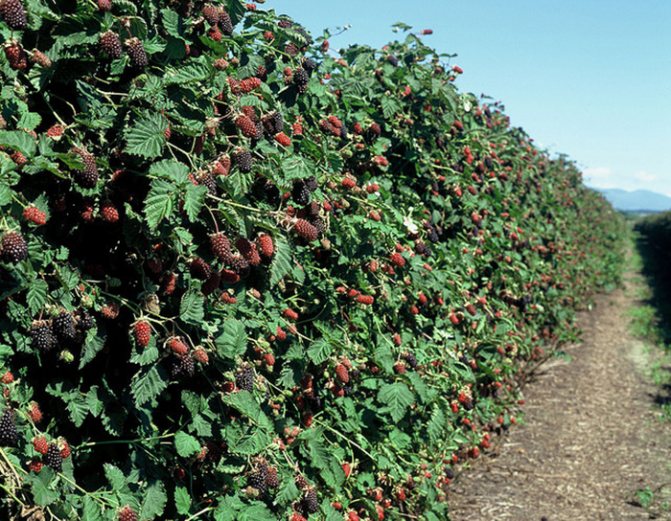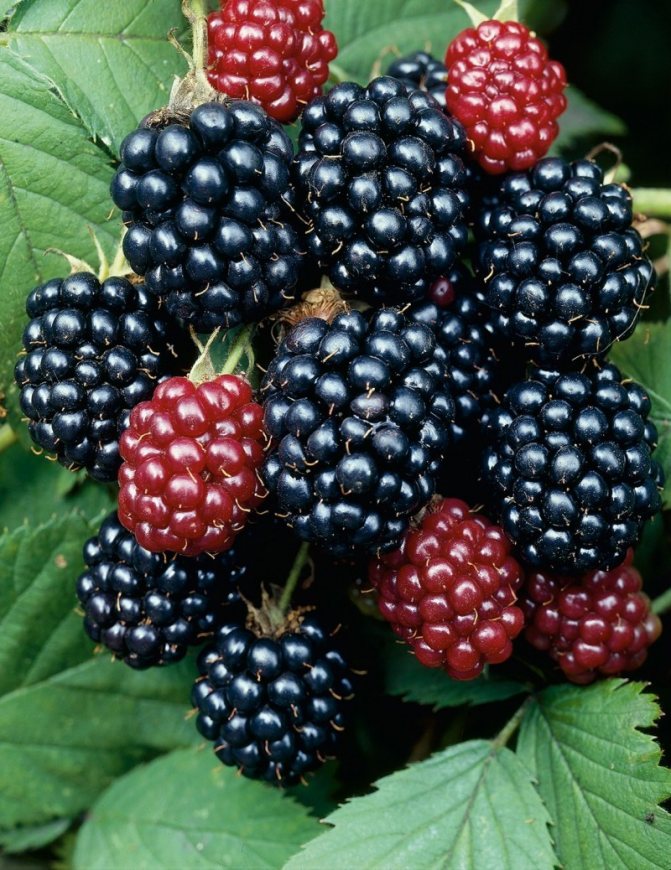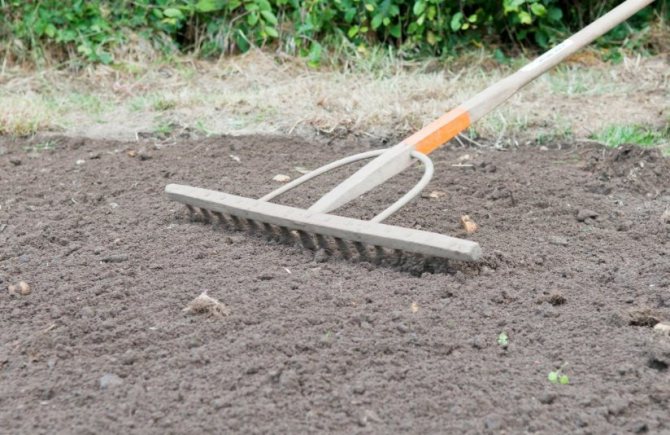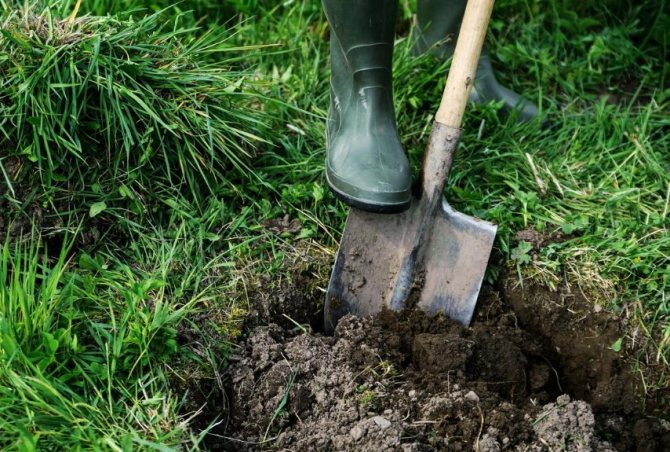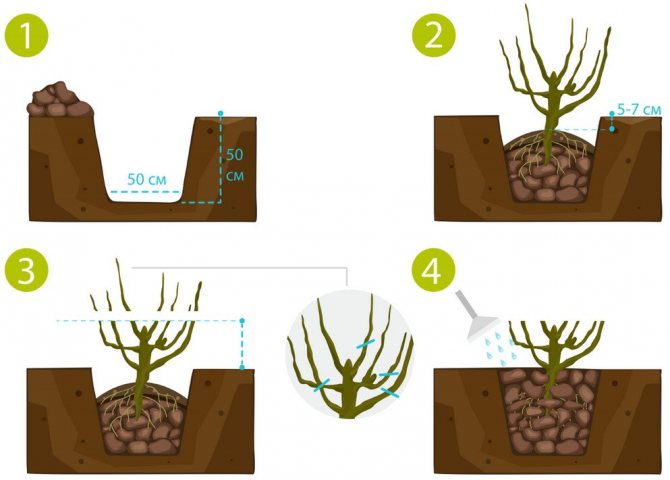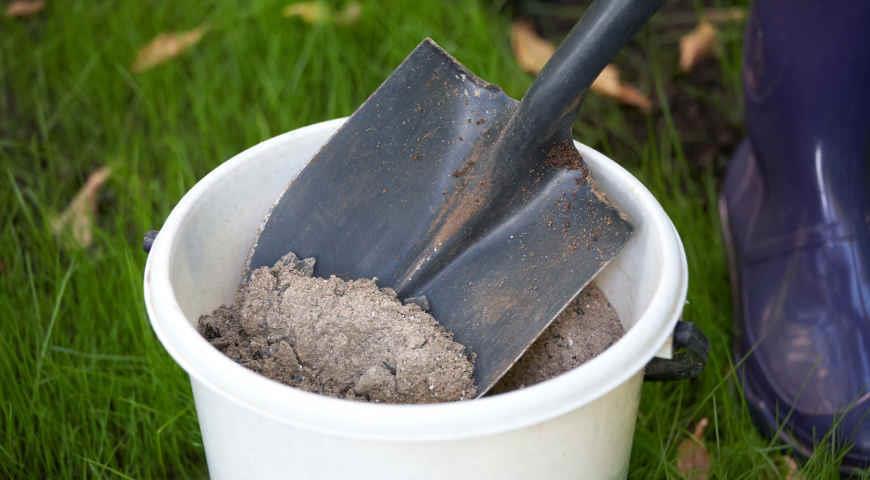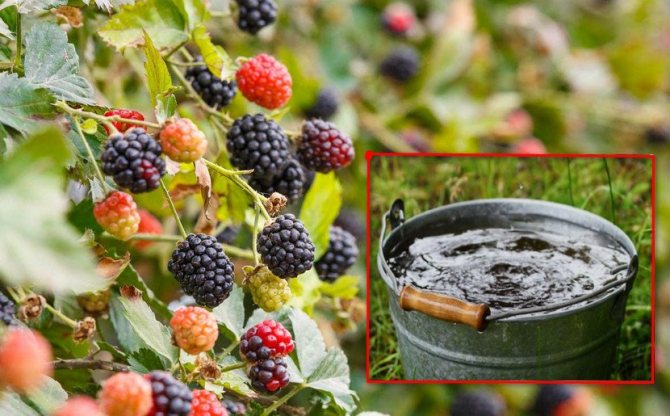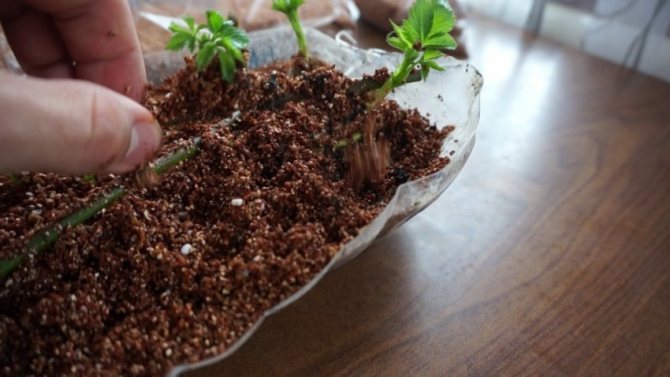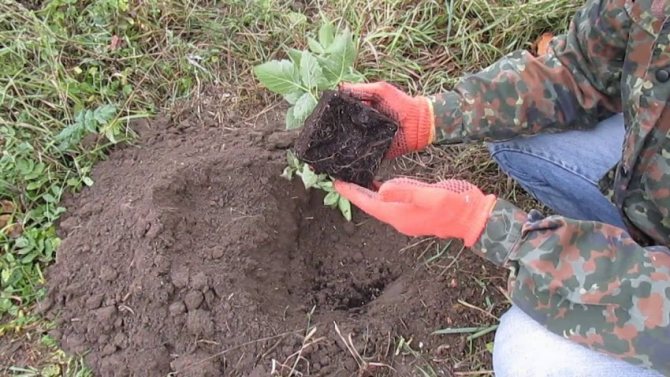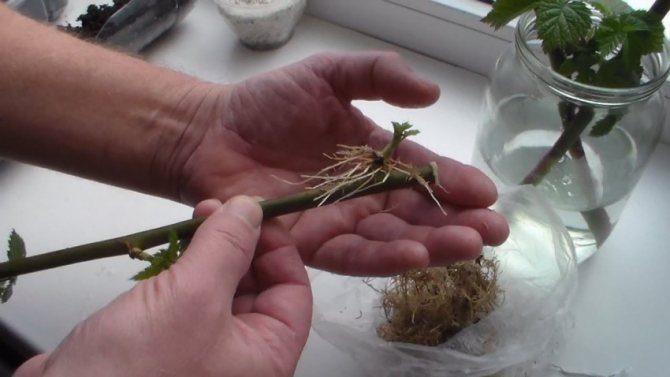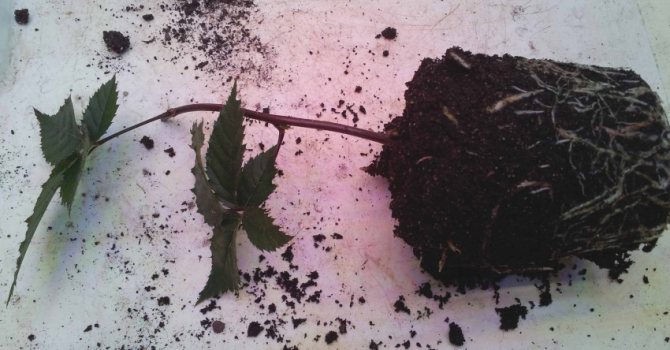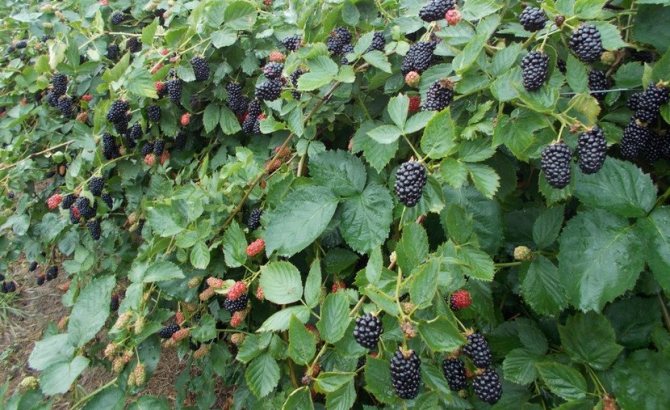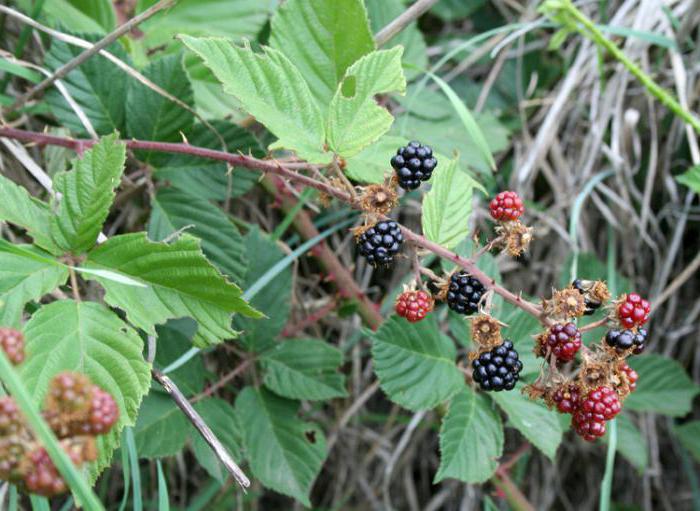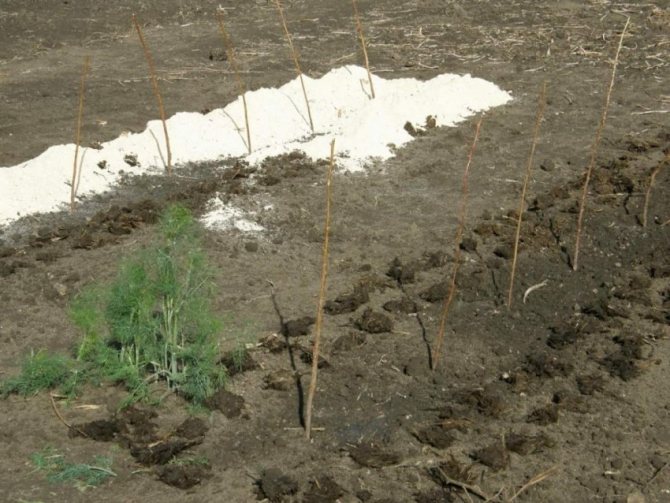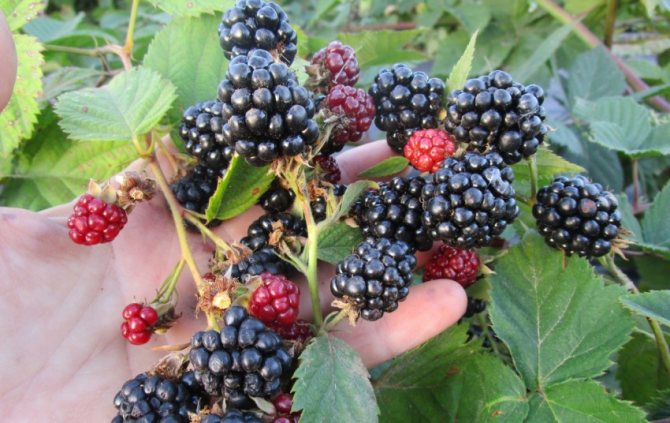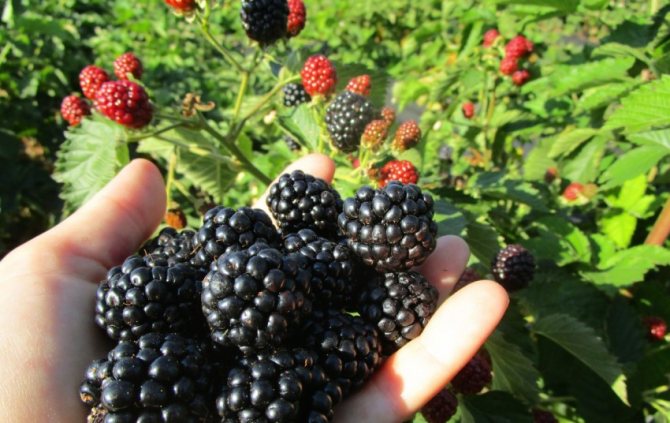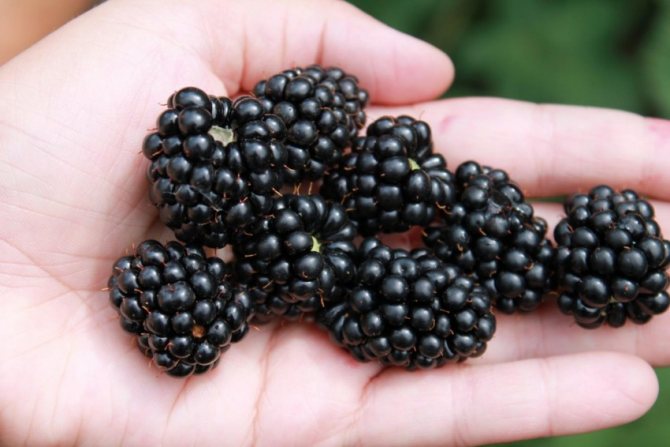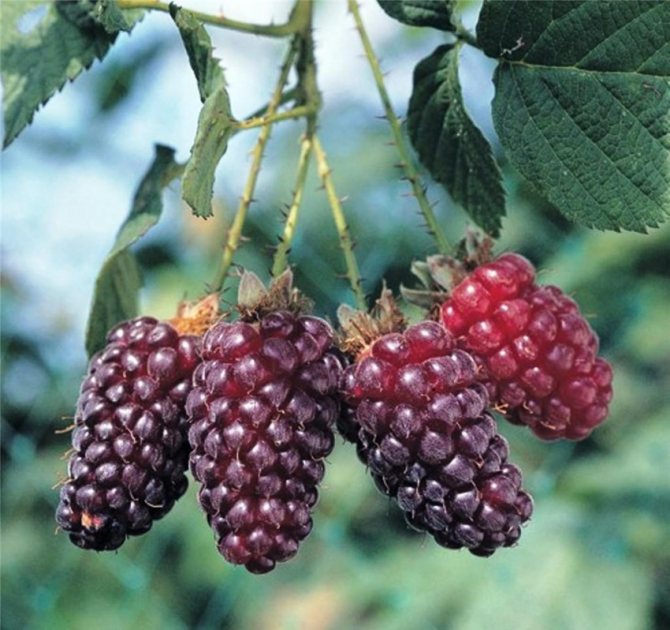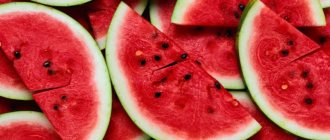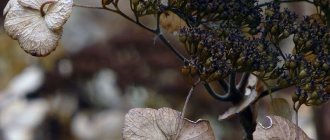Wild blackberries reproduce very quickly in natural conditions. In literally one season, it can “settle” on vast territories. This culture is not at all afraid of prolonged droughts, temperature fluctuations and the proximity of groundwater. This berry is a storehouse of vitamins, so it is not surprising that many people try to have it in their summer cottages. For these purposes, a special garden blackberry is selected. Planting and caring for, reproduction of such a culture is not an easy task, it will require a lot of effort and time. The varieties that are grown in garden plots are different from their “wild relatives”. They are quite gentle and moody. In order to harvest a large harvest every year, you need to choose the right place for planting, prune and, of course, regularly care for the crop. But the divine taste of the berry will fully reward the gardener.
Care, cultivation, reproduction of blackberries, in the opinion of most people, are very difficult procedures, therefore it is important, before planting this crop, to familiarize yourself with its features.
Description
Garden blackberry is a perennial shrub. It has flexible stems. Most varieties have sharp thorns on the branches. They can be inconvenient during harvest. Currently, breeders have developed varieties that do not have thorns. They are distinguished by stable fruiting, resistance to diseases and pests.
On average, blackberry shoots are capable of growing up to 1-1.5 m. There are also those whose height reaches 2-3 m. Leaves grow on the shoots that have an unusual serrated shape - five- and seven-partite or trifoliate. Their color is light green. There is pubescence on both sides.
During the flowering period, beautiful white inflorescences appear on the blackberry shoots. Their average size is about 3 cm. The flowering period is from June to August, depending on climatic conditions. Flowers are a honey plant, therefore they attract insects. Ripe fruits are black. You can see a bluish bloom on them. Harvesting takes place around the end of summer (depending on the variety). Blackberry has a sweet taste with slightly noticeable sourness. The fruits are very juicy.

Choosing the right seedling
It is advisable to purchase planting material in special nurseries, where various forms of garden and remontant blackberries are presented.
The repaired variety receives more positive reviews - its fruiting is more extended, and its resistance to climatic conditions and diseases is much higher.
As for the level of branch formation, from this point of view, it is better to give preference to annual specimens with several shoots, the diameter of which is more than 0.5 cm.
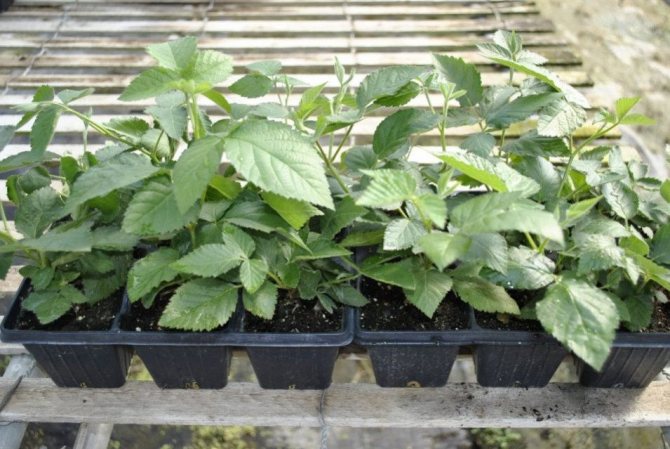

Also pay attention to the rhizome - it should look healthy, with no signs of decay. A peephole should already be formed on it. An hour before rooting, the roots can be held in a solution of 1 liter of water and 1 tsp of 3% hydrogen peroxide.
When to plant?
Growing and reproducing garden blackberries is not yet commonplace. However, given the benefits that its fruits bring to humans, it is not surprising that many gardeners are gradually beginning to master this culture. An important point in this matter is the correct fit.
Many rosaceous crops can be planted in the ground in both spring and autumn. However, for blackberries, the optimal period is from late April to early May. It is at this moment that the earth will already warm up enough.
The most suitable soil for this crop is sandy and drained soils. The optimal hydrogen index, at which blackberries grow well and bear fruit, is pH 6.
Immediately before planting a bush, it is necessary to dig up the ground in the selected area. Remove debris and rhizomes of plants that grew earlier in this place. It is advisable to carry out these procedures in the fall. If the soil is fertilized regularly, then there is no need to specially add groundbait. An overabundance of minerals can lead to the fact that the bush will begin to grow a green crown very quickly, and this will affect the quality of fruiting.
If fertilizers were not applied regularly, it is recommended to use mineral and organic substances in the area where blackberries will be planted. They are entered on the basis of the following calculation (per 1 sq. M):
- organic matter - 10 kg;
- superphosphate - 15 g;
- potassium sulfate - 25 g.
Features of autumn planting of blackberries
Autumn transplanting of young blackberry bushes into open ground is practiced in areas where autumn is long and warm. The culture is difficult to tolerate low temperatures, there is a risk of freezing of immature young plants.
When can you transplant?
If frosts down to –20 ° C are expected in winter, then even frost-resistant varieties are sheltered after transplanting in the fall for the period of cold weather.
Did you know? The British have many superstitious traditions associated with blackberries. For example, in England it is believed that a person who picks berries after October 11 will be desecrated - supposedly on this day the devil himself is hunting for blackberries.
It is important to have time to plant seedlings a month before the arrival of the first serious frosts. The optimal terms for this procedure will be the beginning of September - mid-October, when the temperature indicators fluctuate within the range of + 11 ... + 25 ° С.
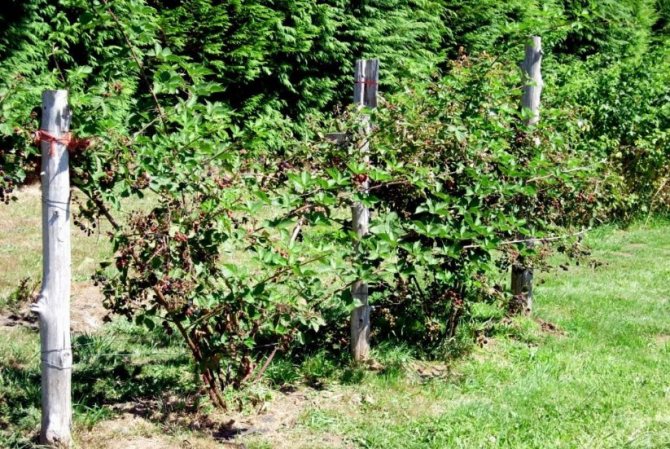

In this case, the transplanted bush or cutting will have enough time for rooting and adaptation to new conditions before the onset of frost.
Benefits of an autumn transplant
- Autumn transplantation is preferred by many gardeners, arguing this with the following advantages:
- In autumn it is easier than in spring to provide future plantings with the necessary conditions, the most important of which is the warmed-up soil. In addition, it is recommended to free the soil from weeds and fertilize it in the autumn months.
- If the young bushes transplanted in the fall can easily survive the first winter, in subsequent years they will please with resistance to weather conditions and resistance to ailments.
- In the autumn months, the sun is not as scorching as in the summer, so the bushes will feel more comfortable.
It will also be useful for you to learn about the rules for transplanting such berry bushes as raspberries.
Seat selection
For those who decide to breed blackberries, it is important to know which place is optimal for a given culture. First of all, she is sun-loving. Before disembarking, it is necessary to select a site that will be well lit. It is also important to pay attention to the fact that flat places are not suitable for blackberries. The southern or western slopes are optimal for this culture. It will be useful to protect the bush from strong winds. Garden varieties can be affected by bad weather.
Some gardeners who have been growing blackberries for a long time have noticed that this crop grows well in the shade, but its berries are small and not sweet enough. Also, when choosing a place for planting, it is important to pay attention that this area is not too moisturized, since the bush will simply rot.
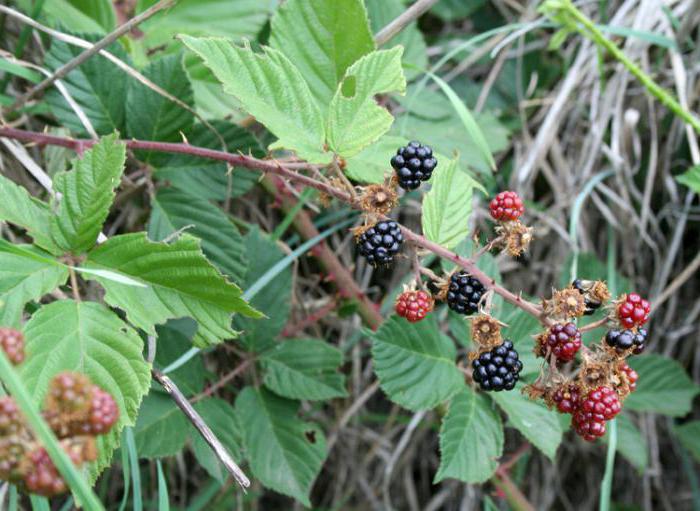

Landing rules
A hole for a blackberry seedling should be dug large. The root system of the plant must fit completely in it.Its approximate width and depth is 50 cm. Before planting, you should prepare a soil mixture suitable for this culture. They make it from garden soil and compost. A very good solution would be to add 100 g of superphosphate and 35 g of some potassium fertilizer to the soil.
Part of the mixture is poured into the pit immediately. Then a seedling is lowered into it. Further, the roots are covered with soil so that the root collar of the plant protrudes about 1 cm above the ground. At the final stage, the ground around the seedling is compacted and thoroughly spilled with warm water. It is possible to plant blackberries according to the technology described above both in autumn and in spring.
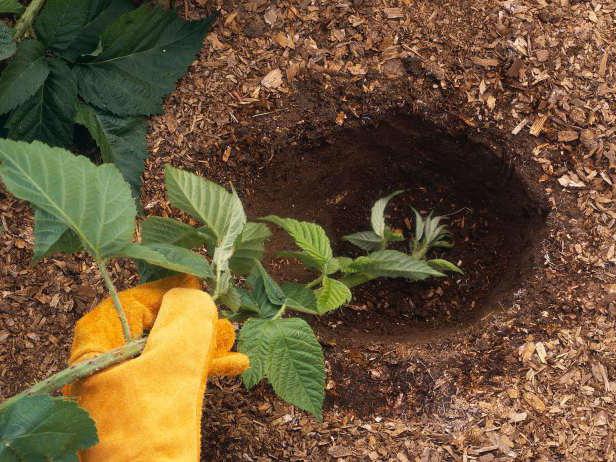

Care
Before breeding blackberries, you must familiarize yourself with the rules of care. This culture will not give a full harvest if you do not carry out certain procedures. These include loosening the soil, regular watering, removing weeds, and fertilizing.
For full growth, it is necessary to moisten the soil directly under the bush throughout the growing season. Particular attention should be paid to watering during the growth of shoots and berry ovary. Only in October do blackberries stop needing regular moisture.
It is necessary to fertilize the soil at least once every three years. For this purpose, compost is used. The optimal dosage is 4-6 kg per bush. In the interval between these dressings, you can use nitrophoska. The optimal dose per square meter is 20-30 g.
It is also important for gardeners to know that this crop needs periodic pruning. The stem is shortened so that the height of the remaining part is 1.6-1.8 m. We will talk more about how and when to prune the bush a little later.
Watering and caring for transplanted plants
The land under the berry must be watered and loosened periodically. Blackberries have a powerful rhizome, so the bushes do not need abundant irrigation. In the dry season, watering is carried out once a week before the onset of frost.
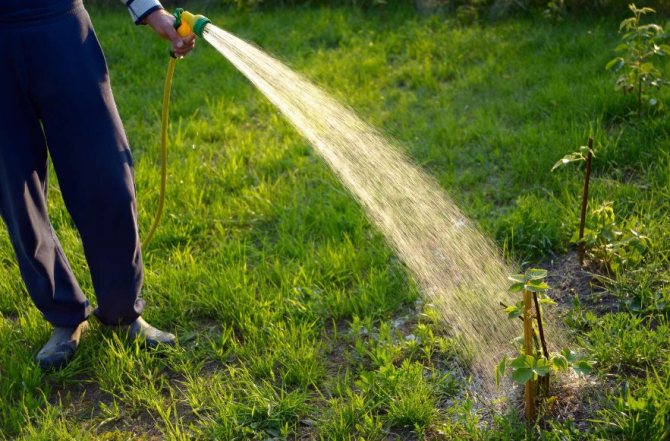

After transplanting the blackberry, do not rush to fertilize the plant, give it time to take root. It will not be superfluous to carry out preventive treatment for ailments and harmful insects. Treat the planting with a solution of 1 liter of water and 1 tsp of 3% hydrogen peroxide.
Reproduction by root suckers
Blackberry propagation can be carried out using root suckers. This method is great for breeding bush varieties. The procedure is usually carried out from late spring (May) to early summer (June). For the offspring, shoots are selected that have already reached a height of approximately 10-15 cm. The optimal length of the rhizome in this case is from 15 to 20 cm. It is also necessary to pay attention to the thickness of the stem. It should be at least eight millimeters at the base.


Preparing blackberry cuttings
Green cuttings are cut from the bush in July. It is difficult to propagate with their help, since the roots are formed only in every tenth cutting.
Reproduction of currants by cuttings in spring
Rooting requires a high air humidity without drafts and a constant air temperature. It is difficult to provide such conditions in the garden; a special greenhouse and equipment are needed.
Maintaining the required air temperature at home is possible, but ensuring high air humidity in a city apartment with central heating is an almost impossible task.
It is better to reproduce with lignified cuttings, which are prepared in the fall. On annual ripe shoots, flat areas are selected, about 40 cm long.
Alternatively, you can propagate blackberries in the spring in this way, without waiting for autumn.
Cuts are made with clean, sharp pruning shears perpendicular to the stem. Thorns must be cut. Prepared cuttings are stored in a hole in the garden.To do this, you need to dig a hole or trench in the ground about 30 cm deep and place the planting material there.
Additional Information. If necessary, you can store the cuttings in the refrigerator at home. To do this, they are placed in a plastic bag and placed in the lower compartment. Periodically, the bag needs to be removed and the contents aired.
Blackberry propagation by layering
This method is mainly used for creeping varieties of this crop. Its essence lies in the fact that an inseparable shoot from the parent bush is buried in for rooting. It is worth noting that experienced gardeners consider this method to be the most effective. It is likely to produce many young shoots. Next, we will consider the technology of propagation by layering.
- Dig the soil at least 30 cm deep near the parent bush.
- Add a small amount of sand to the soil.
- Grind the clods of earth.
- Cut off the leaves at a distance of about 30 cm from the top of the shoot.
- Make an oblique cut in the middle. Its length should be approximately 5 cm.
- Treat the slice with a hormonal drug.
- Dig a saucer-shaped hole no more than 30 cm deep.
- Place the cut in the ground, secure with wire and sprinkle.
- Make a vertical support to which you can tie the upper part of the shoot.
- In the place where the branch is dug in, the soil must be slightly compacted.
If you follow all the steps sequentially, then planting the blackberry will not cause any complications. Reproduction in this way guarantees one hundred percent result. But! The culture will quickly take root only if the soil is periodically moistened. Watering is stopped only when the shoot has taken root. The duration of this process is approximately one year.
In order to check whether the rhizome has grown, the shoot is slightly raised. Cutting off a branch from the parent bush is recommended in the fall or spring. In the latter case, the young shoot is immediately transplanted to a new, previously prepared place.
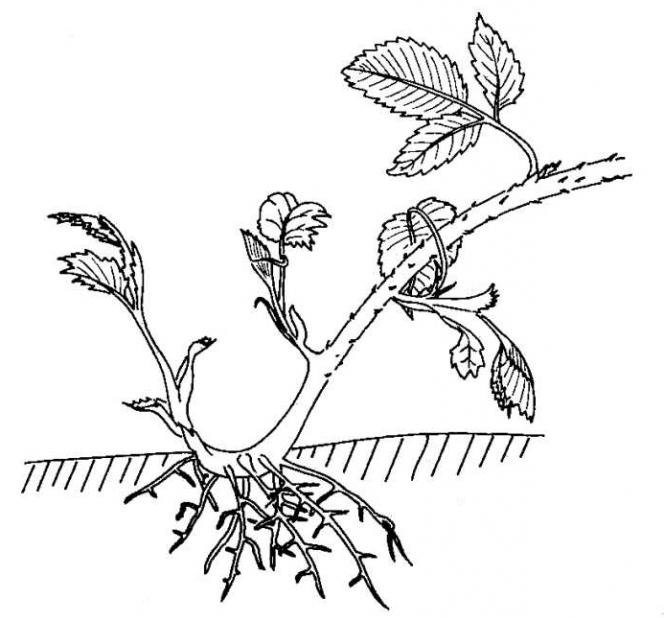

Fall transplant errors
Try to avoid common mistakes that can occur when replanting blackberry bushes in autumn:
- The distance between bushes is the most common mistake newbies make. Planting too densely blocks the access of plants to light and nutrition, and also complicates the process of caring for the berry. The voids left behind bring a loss to the farm. Of no small importance is the type of blackberry, therefore, before purchasing planting material, you should familiarize yourself with the requirements of agricultural technology of a particular variety.
- Inexperienced gardeners make a gross mistake by feeding organic blackberries in the fall. (unripe manure, bird droppings). This threatens the freezing of shoots and the growth of pathogenic flora under the covering material.
- Do not rely on high cultural immunity - although infrequently, seedlings are infected with fungi that cause gray rot, verticillosis and other ailments. Try to choose healthy and sturdy planting material.
- Take your time to install the blackberry supports. The trellis can be organized when there is a need for it - when the bushes are of sufficient size.
- A big mistake is driving in support pillars in the area of the site where the bushes grow. Instead, the plants themselves should be planted directly along the support structure.
- And another oversight lies in placing blackberries in a place where vegetable crops previously grew.
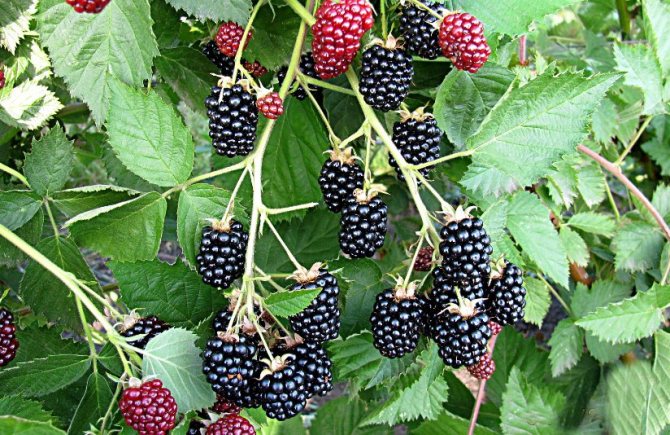

There are no special warnings for planting blackberries in the autumn. On the contrary, transplanting this season has many advantages.
Did you know? The leader in the production of blackberries today is Mexico.
Follow the above recommendations, and blackberry bushes will delight you with an attractive appearance and provide an opportunity to enjoy the fragrant and valuable berry.
Propagation by root cuttings
Blackberry propagation is carried out in several ways, including root cuttings. This technology is perfect for both bush and creeping varieties. It is used if the bush gives few root suckers. For this breeding method, both spring and autumn are suitable. In the first case, the optimal time is the end of March, in the second, November.
In order to carry out propagation by root cuttings, you will need to completely dig up the entire bush. Then it is cut into several parts, carefully separating the roots.
If the procedure is carried out in the fall, then the cuttings must be stored in wet sand until early spring. The best place for this is the basement. If these actions are carried out directly in the spring, then the prepared material can be immediately planted in a permanent place, observing all the rules.
How to propagate blackberries in the fall
Blackberries can be propagated at any time of the year, except for the winter months. The advantage of autumn reproduction is that the plant begins a dormant period, and in winter, natural stratification occurs (acceleration of germination under the influence of cold temperatures), after which the seedlings become more hardy.
In the fall, you can get new copies of blackberries in the following ways:
- dividing the bush;
- horizontal layering;
- root cuttings;
- stem cuttings;
- sleeping kidneys.
By dividing the bush
In this way, varieties and hybrids of blackberries are propagated, which do not give young offspring. Autumn is the best time for this procedure. The division of the bush is carried out before the autumn pruning in September - early October, so that the seedlings have time to take root well before the first frost. Procedure:
- Water well under the bushes 1-2 days before dividing. If the soil is dry, the roots of the blackberry can be severely damaged.
- Along the perimeter of the bush, at a distance of 30–40 cm from the root collar, make a groove with a shovel. Chop off the roots that are outside of it.
- Dig up the bramble bush carefully by digging in on all sides with a shovel.
- Shake it lightly to free the rootstock from the soil.
- Divide the roots of the plant into several pieces using a garden knife. Each division should have 1–2 shoots of the current year with roots.
- Clean the cuttings from old stems, cut off damaged and rotten roots with pruning shears. Shorten the shoots to 30 cm. All cut-off parts should have 2-3 shoots, and at least 1 underground bud should be present on the roots.
- Immediately plant the resulting seedlings in a permanent place, in pre-prepared holes.
- Blackberries grow shoots up to 5-7 m long, so do not spare space. The distance between seedlings in a row should be about 3 m, and between rows - about 2 m.


Up to 5 seedlings can be obtained from one blackberry bush
If some shoots are rootless, do not worry and plant them in the ground. Blackberries reproduce even by root particles, so they tend to take root.
Horizontal layering
In this way, you can grow a large number of young blackberry bushes. To do this, you need to do the following:
- In early August, bend the shoot of the current year to the ground and, without separating it from the bush, dig a shovel on the bayonet.
- Leave its top above the soil surface and cut 10 cm to stop further growth.
- Tamp the soil and secure the shoot with a stone or hairpin so that it does not straighten out.
- Mulch and regularly water the soil where the scion is dug.
- At the beginning of October, use a pitchfork to dig out a layer with new rooted seedlings.
- Cut off the seedlings and plant them in another place.
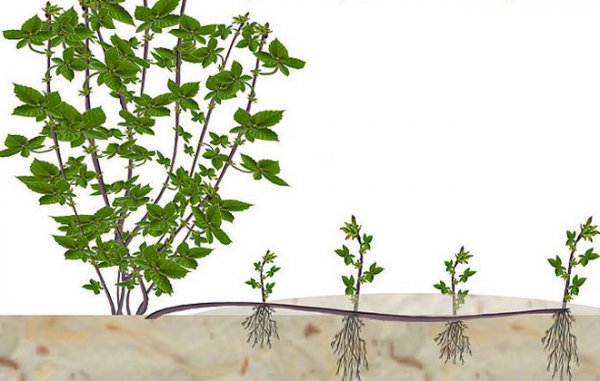

When propagating blackberries with horizontal layering, you can get a large number of seedlings.
If the shoot is buried in the fall at the end of September - early October, then the young seedlings are planted next spring.
Video: blackberries, reproduction, the easiest way
Root cuttings
This method gives good results - up to 70% of new seedlings. Procedure:
- In November, dig in the blackberry bush, cut the root cuttings, and then bury again.
- Choose cuttings 6–9 cm long and 0.3–1.5 cm thick.
- Fold them in a bag and place them in the refrigerator or cellar. The storage temperature should be no higher than +5 0 С.
- Air and inspect the cuttings every 5-7 days.
- At the end of February, lay them out at the bottom of the container, sprinkle with earth to a height of 3 cm and place them on the windowsill for germination.
- In April, plant the seedlings in the garden in the place of your choice.
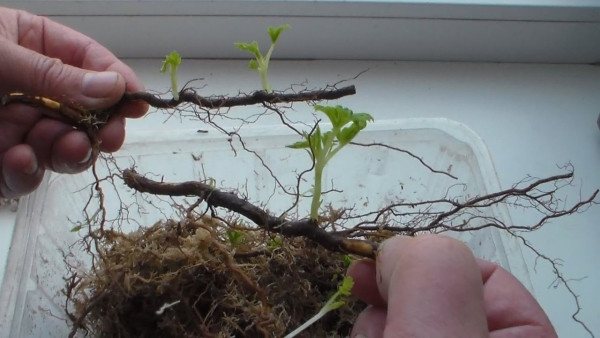

Up to 70% of root cuttings give new seedlings
The material can also be cut when replanting the bush to a new location.
For blackberry varieties without thorns, propagation by root cuttings is not suitable, as it becomes prickly.
Video: reproduction of blackberries
Stem cuttings
The method is simple and versatile, allowing you to get many seedlings at the same time. Algorithm of actions:
- In October, when the shoots of the current year become woody, cut the cuttings about 40 cm long.
- Bury them in the ground to the depth of a shovel bayonet.
- In April, after thawing the ground, dig up the cuttings and cut their ends again.
- Place the overwintered material at a distance of 10-15 cm from each other and sprinkle with soil.
- For better germination, stretch the film over the cuttings on arcs. Water and weed regularly.
- As soon as the shoots with 2-3 leaves appear, dig up the cuttings. Young shoots of blackberries with roots are formed on them.
- Divide the seedlings and plant them in pots for further growth.
- When the stems of the blackberry bushes grow and new leaves appear, plant them in a permanent place.
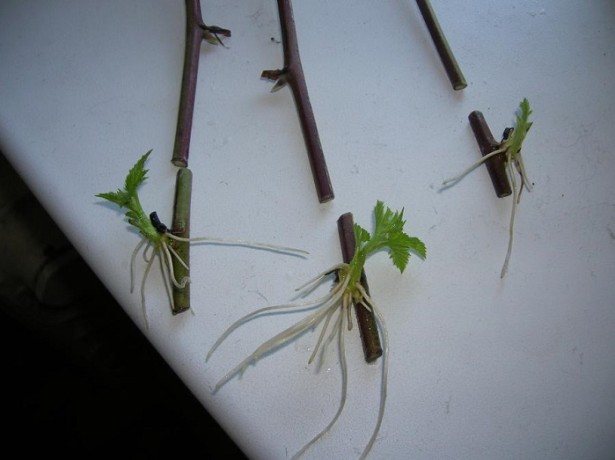

Separate seedlings and plant in grow pots
Video: blackberry propagation by stem cuttings
Dormant bud propagation
This method takes a lot of time, but gives almost 100% results. Procedure:
- In October, cut annual cuttings with 2-3 buds, no more than 15 cm long. Be sure to remove the leaves. Store them in a refrigerator or cellar.
- In February - early March, remove the cuttings and place them in a jar of water, top bud downwards. Only one of these buds should be in the water.
- Keep the jar of cuttings on the windowsill and periodically add the evaporated water.
- A sprout with roots appears from the awakened bud. Cut it off and plant it in a pot of growing soil.
- Dip the second bud in water, it will also sprout. In this way, wake up all the buds on the handle.


Place the blackberry cuttings in a jar of water, bud top down.
The roots appear precisely on the apical bud, for this they turn the stalk upside down.
You can propagate blackberries in another way. Place the stalk with the bottom cut in a jar of water, and dig the apical bud into a pot of damp earth. A sprout with roots will appear from it. When 2-3 leaves are formed, cut off the sprout from the cutting and leave in the pot for further growth.
In order not to confuse the upper and lower buds of the cutting, I make the upper cut straight, and the lower one obliquely.
Video: blackberries from bent branches, buds
Having at least one blackberry bush on your site, you can perfectly propagate it in the fall. Choose the method that works best for you and follow the recommendations.
Propagation by cuttings
Blackberry propagation by green cuttings is practiced by gardeners quite often. Algorithm of actions:
- Single-bud green cuttings are cut in early summer.
- Soil is poured into small pots. It is made from peat and sand (1: 1).
- After preparing the containers, the cuttings are planted and covered with any material to create a greenhouse effect. It is important to pay attention to the fact that high humidity is maintained under it - up to 95%.
The root system is formed in about a month. Then the shoots are planted in a permanent place.
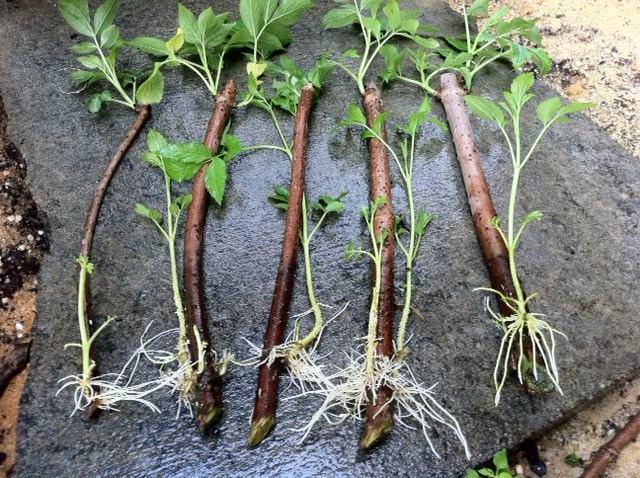

Landing dates
The exact time of planting blackberry bushes strongly depends on the characteristics of the local climate. The main thing is to place the plant in the ground 20-30 days before the onset of real cold weather. The seedling must have time to root well in a new place.
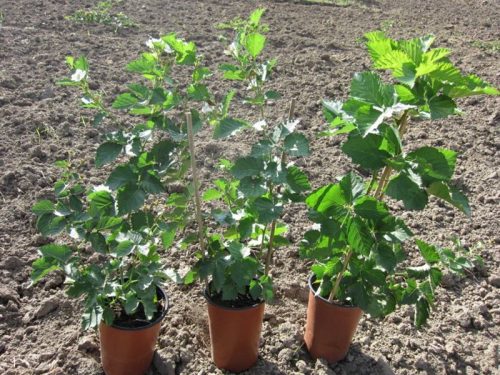

Blackberry seedlings should have time to take root before winter
In the northern regions with harsh climatic conditions, planting is carried out from the end of September to the first days of October. The mild warm climate of the southern regions allows you to postpone this period until November and even until mid-December.
A blackberry bush planted in autumn develops its root system until frost when the soil temperature drops to -4 ° C.
Video: when to plant blackberries
When to prune blackberries?
Whatever blackberry grows on the site, care, cultivation, reproduction and pruning of this crop are troublesome activities, so you need to be ready for them in advance. The above were the main points that will help the gardener choose a planting site and properly care for this plant. Also, importantly, several methods of reproduction are described in detail. Now you need to consider when to prune the blackberries. The process itself is quite complicated, it is performed regularly. With the help of a pruner, the treatment of bushes is carried out in all seasons, except for winter.
Currently, there are two types of blackberries: erect and creeping. The latter does not give root shoots, and a large number of fruit branches are formed on the shoots. As for straight-growing varieties, the height of the bush can reach 3 m. Only two-year-old shoots bear fruit, so it is important to prune on time.
Blackberry - care
For the first 3 years for caring for a blackberry, it is enough to fertilize it in the spring, when the buds open, and in the fall, at the end of fruiting, with nitrogen preparations. New shoots in the first summer must be formed immediately - this will make caring for the plant more convenient in the future.
For the same purpose, blackberries, planting and caring for which are accompanied by the construction of trellises, are tied to them. Trellis are two jays along the edges of a row with 3-4 wires fixed between them.


Basically, caring for a shrub consists of regular watering, loosening the soil and weeding. In the spring, blackberries, planting and caring for which have lasted for 2 years, must be fed with a full set of preparations, including phosphorus, potassium and nitrogen. Branches frozen in winter are cut to a healthy bud.
All sprouted shoots are removed in autumn, and young branches, shortening them to 2/3 of the height, are tied to trellises. Before the onset of cold weather, all branches are removed, bent to the ground, fixed and covered with straw from frost. When the snow falls, plants are additionally snatched with it.
How to trim?
With the arrival of spring, you will need to cut off all dry and deformed branches. The tops, which are "nailed" by frost, are also removed. This procedure is carried out before the kidneys awaken. Those bushes that were planted last year should be pruned twice: in May and June. First, the tops of the branches are shortened by 5-7 cm. For the second time, those shoots whose height has reached 1.5 m are subjected to processing. They must be shortened by about 10 cm. Also, all side branches are examined, the weakest of them are selected and cut off. At the end of the work, 6-8 strong shoots should remain.
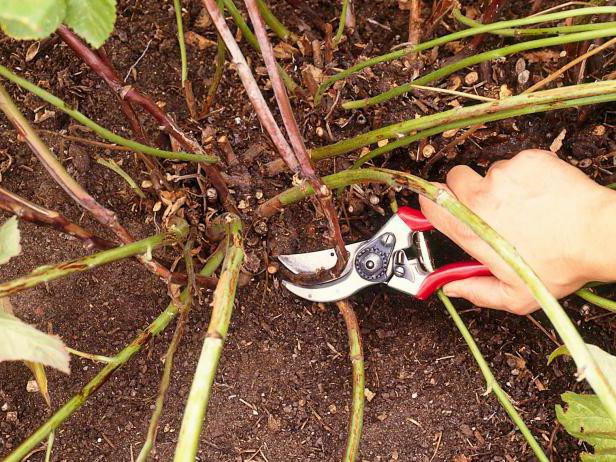

In the summer (vegetation) period, it is necessary to cut off all root processes. Only those that appeared in the spring are left, because it is on them that the berries will appear next year.
With the onset of autumn, pruning is done at a height of 1.7 to 2 m. Weak branches are also removed. You need to cut them at the very root. It is important to note that the shoots stop bearing fruit after two years, so they must also be removed.
Description and types of blackberries
There are many types and varieties of these berries.
According to the method of stem growth, two types are distinguished - erect (kumaniks) and creeping blackberries (dews). In terms of yield, mildews are more valuable than kumaniks, however, their creeping shoots make the growing process more laborious and costly.
Kumaniki have stems growing vertically, some of them are slightly drooping ashy color. Their height is about three meters. Young plants grow from buds placed on the roots. Usually these are thorny, winter-hardy forms. Kumanik flowers are self-pollinating. The fruits are large, distinguished by their brilliance.
Rosyaniki have oblong creeping stems with fruit branches placed perpendicularly. The presence of thorns is determined by their variety and type. It is from the dews that the thornless varieties of blackberries are produced. Fruits are black or dark red, very large, juicy and have taken precedence in taste among erect varieties.
Mildews bear fruit earlier and more abundantly, but they do not tolerate frosts very badly. The varieties of this species are Izobilnaya, Texas, Lucretia. They all reproduce by rooting apical buds.
.
Consider the popular varieties of blackberries:
- Agave -the most frost-resistant variety. Survives even in 40-degree frosts. Plants have tall, arched shoots with strong thorns. The berries weigh about three grams, black, sweet with sourness, insanely fragrant. Ripening begins in August. One bush can please you with four kilograms of berries. The variety is resistant to disease.
- Darrow - is also a fairly persistent and high-yielding variety, tolerates 30-degree frosts. The bush is large, the shoots are straight, covered with thorns. The berries weigh up to four grams, their shape is conical, the color is black, shiny, the taste is slightly acidic.
- Wilsons Earley- one of the varieties that delight with an early harvest. The fruits begin to ripen in July. It tolerates frost relatively well. Shoots are straight, drooping in places, with medium-sized thorns, reaching up to two meters in height. The berries are small, black with a purple tint, egg-shaped, weighing about two grams.
- Lucretia - creeping variety. The bush is large, strong, with a huge number of shoots covered with thorny thorns. This variety is not winter-hardy at all, it lends itself to infection with diseases. Its advantage is large berries that ripen early.
- Abundant- a high-yielding variety. It has a large bush with elongated shoots. They spread along the ground and are covered with curved thorns. The berries are large, weigh up to ten grams, sour, ripen late.
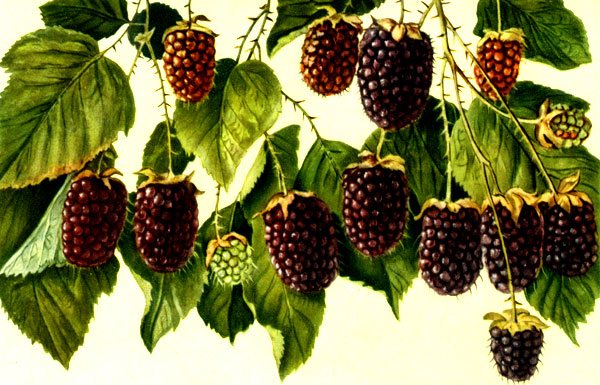

Abundant


Lucretia
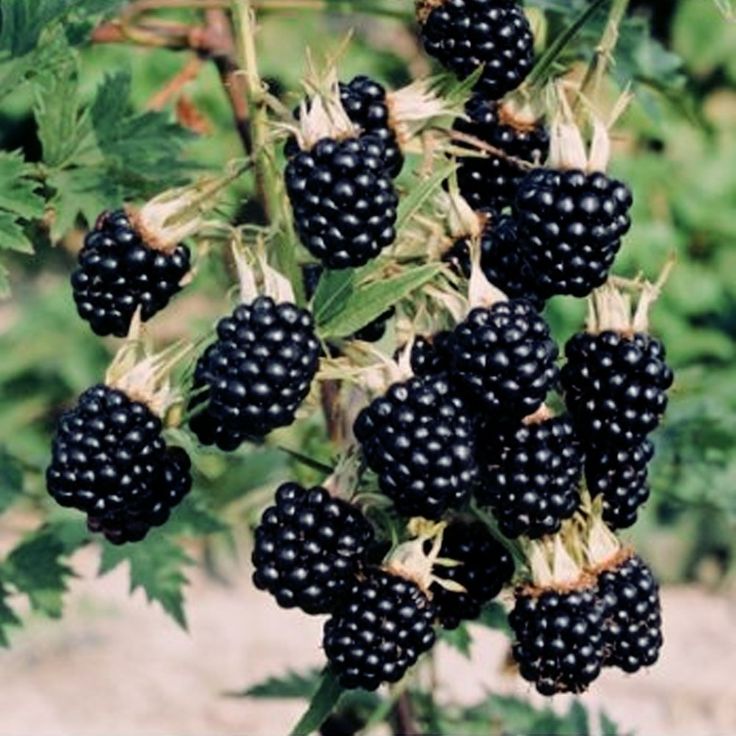

Wilsons Earley
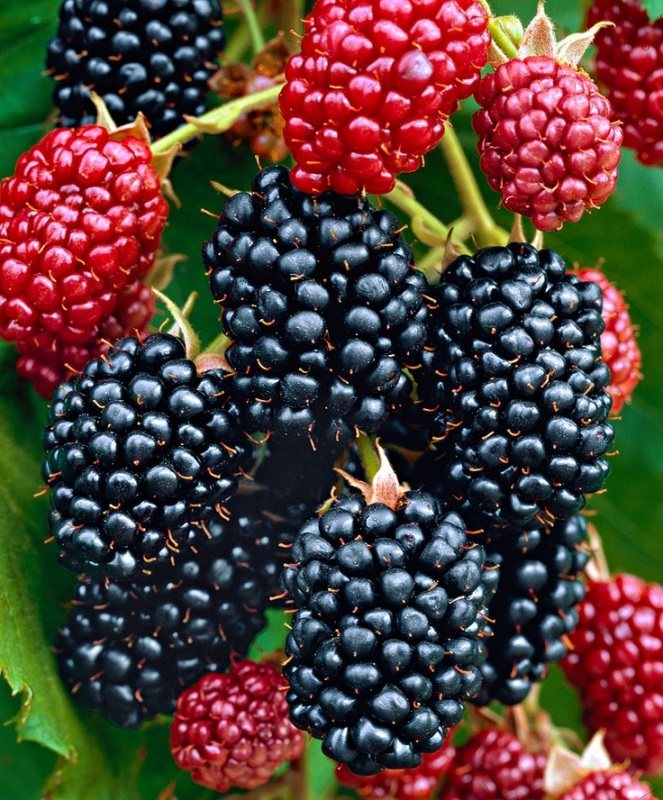

Darrow
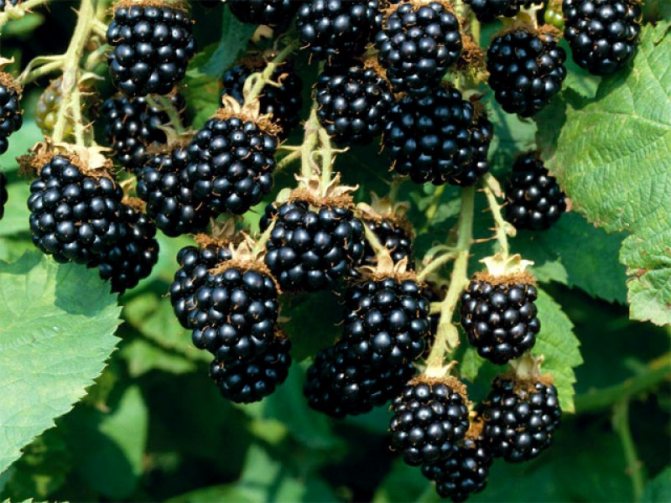

Agave
In the process of breeding, blackberry varieties were bred without thorns, characterized by low winter hardiness, but having a rather high annual fruiting. There is a remontant thornless blackberry that can bear fruit for a very long time up to frost.
Caring for blackberries after pruning in the fall and preparing them for wintering
After the completion of the autumn pruning, some more manipulations need to be carried out: After all the work, it is necessary to remove all the remote branches and foliage and burn it. This is necessary in order to prevent wintering in them and the further development of pathogenic microorganisms. The soil and blackberry plantings are treated with 1% copper sulfate or any fungicide to destroy fungal infections. The soil around the blackberry bushes must be mulched with sawdust, peat, spruce branches, rotted manure or straw. After that, you need to start sheltering the bush for the winter. The branches of curly varieties are collected in a bunch and pressed to the ground, strengthening with hooks or stakes. Erect varieties have the worst flexibility, therefore, they need to be prepared for shelter since August (to attach a load to the top of the bushes, which contributes to their bending to the ground). After the end of the leaf fall, the branches are finally pressed to the ground, fastened and covered in the same way as climbing shrubs.
loading ...
When can you transplant blackberries to another place
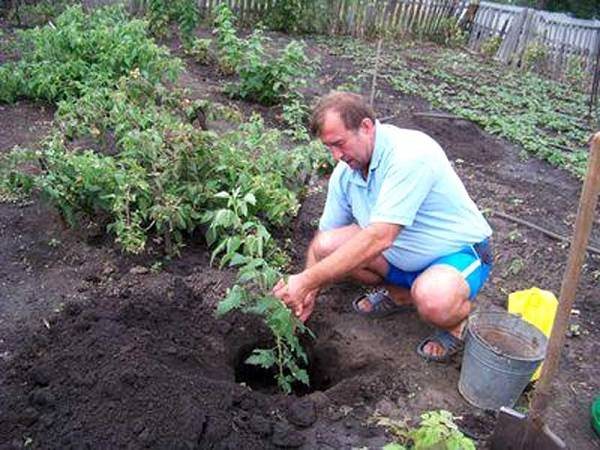

The specific timing of transplanting in the spring is determined by weather conditions. Usually falls in April. In May, the blackberry should not be touched any more. The plant begins an active phase of sap flow.
The time of the autumn transplantation falls on the end of September - the beginning of October, provided that there are no early frosts in the region.
Attention! A seedling transplanted in the fall, even of a frost-resistant variety, is sheltered for the winter.
Preparing for winter
Blackberries are not a frost-resistant crop, they are afraid of frost below -20 ° C. Residents of the southern regions, where the winters are warm, do not have to worry about the insulation of the bushes. In the middle lane, you need to cover the plant from frost in time, and also know when to remove this insulation.
Important! Winter thaws with subsequent frosts are very dangerous for blackberries, they can lead to icing and freezing of shoots. To prevent this from happening, the bush is additionally covered with dry foliage or pine branches, which take excess moisture onto themselves.
Shelter
Covering blackberry bushes for wintering should be at a time when a stable cooling has come and the average daily temperature does not rise above zero. In the middle latitudes it is the end of October - November, in the northern latitudes - the end of September. In the southern regions, the winter shelter of the blackberry can be omitted at all.
Before covering the plant, it should be bent to the ground. For this, upright shrubs are tied with twine and attached to each other, or to a support, and everything is laid together on sandy or wooden flooring, which will additionally absorb excess moisture.
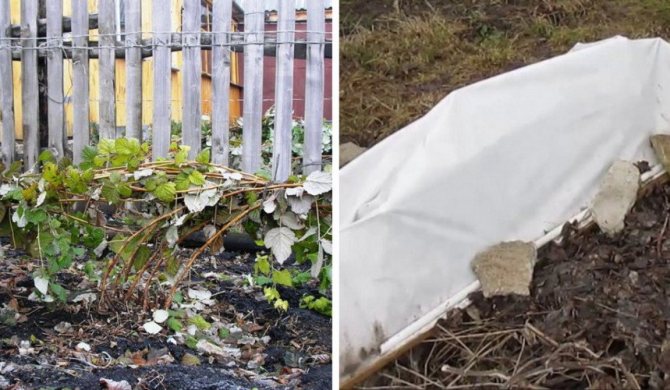

Next, the blackberry is covered with spruce branches and on top with agrofibre or polyethylene, which are fixed with a rope or pressed with metal brackets driven into the ground, or just bricks. In the spring, with the first thaw, the shelter must be quickly removed so that the bush does not dry out and pathogens do not develop on it.
About
Layers
Climbing blackberries are ideal for this breeding method. At the same time, there should be many bushes on the personal plot, since healthy fruit-bearing branches are used here to form planting material, which can reduce the future yield.
In order to propagate the garden blackberry with a horizontal layering, the following manipulations must be done:
- In mid-August, when it will no longer be too hot, dig a groove up to 20 cm deep and put a one-year shoot in it so that only its top remains above the ground. To fix the blackberry branch in the trench, use a hook at the base and end, or press down on top with a brick.
- It is recommended to cut the top of the shoot by about 10 cm. This will suspend growth and redirect all the forces of the future seedling to rooting and developing new shoots.
- Fill the groove with the fixed vine with earth.
- Thoroughly mulch the layers and water abundantly.
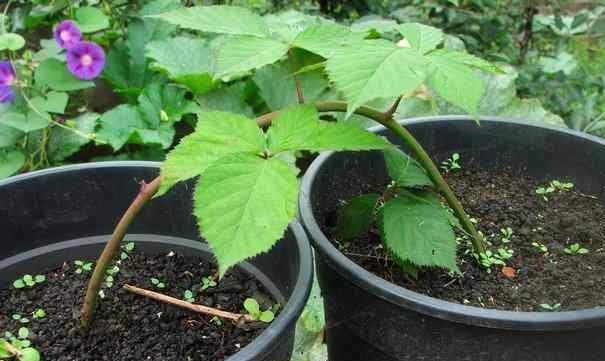

Within one or two months, by the beginning of October, new shoots with their own root system will already appear on the buried branch, which must be immediately dug out, carefully separated from the mother bush, and planted in a prepared place.
If you dig in the cuttings in this way at the end of September, then the newly formed bushes can be transplanted in early spring, when the snow melts.
In addition to horizontal, for this method of breeding, you can also use the apical layering. The tip is trimmed in the same way, but the tip is already added in, and then all the above actions are repeated. Creeping blackberry varieties are very easily capable of propagating by the tips of the shoots. In addition, with this method, the crop will not suffer.
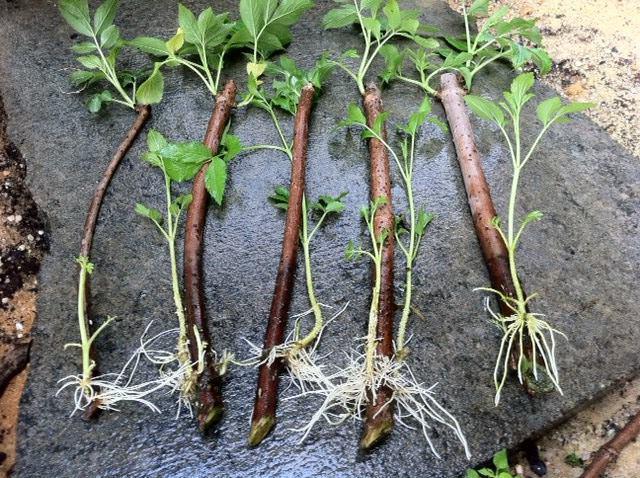

Preparing cuttings for propagation
Important! For faster rooting, experienced gardeners advise cutting the bark in a place that will be in the ground. So the roots will germinate more easily and the young plant will form faster.
With proper care, the cuttings rooted in this way will begin to produce crops already in the second year of independent life.
Pre-winter watering and feeding
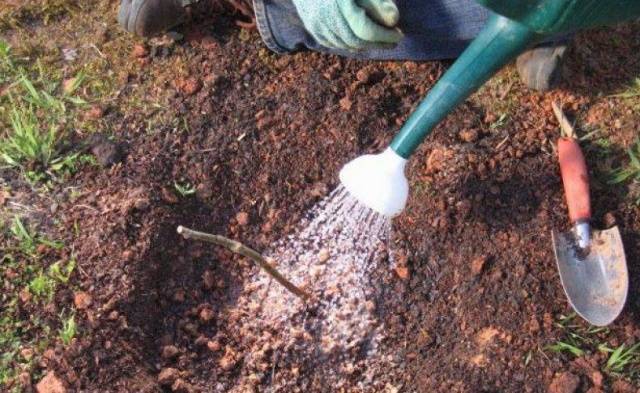

The whole season, caring for an adult bush involves watering about three times. Such a small volume of water is due to the structure of the root system. In blackberries, it goes far into the depths of the earth, where it is able to independently extract moisture. With minimal watering, the bush can live in one place for up to 10 years. Surface moisture is partially retained by mulch.
Obligatory water-charging watering of the plant is needed in the fall before winter before the onset of frost. Simultaneously with the water, top dressing is applied under the bush. For the winter, the plant needs potassium and phosphorus. Fertilizer should not contain chlorine. You can dig compost with the addition of superphosphate under each bush before watering.
Fertilizers for blackberries
It is necessary to feed the blackberry to obtain a bountiful harvest. The basic rules for fertilization include:
- The amount of fertilizer applied depends on how long the crop has been growing on a given land, how much crop needs to be obtained, how densely planted the bushes are, etc.
- Before planting a bush, gardeners, as a rule, spread humus, in the spring - nitrogen and phosphorus, in the fall - potassium.
- Before planting a blackberry berry in the fall, after harvesting previously growing crops, they feed the earth with mineral and organic fertilizers: rotted manure, phosphorus and potassium.
- If a plentiful harvest is not required, and the soil is not of very high quality in the garden, then organic matter and a nitrogen-mineral complex are used for an adult bush that is 3 years old: humus (5-7 kg), ammonium nitrate (40 g), potash fertilizers (25 -30 g), superphosphate (90-100 g).
- In places where the soil is fertile, organic feeding should not be carried out. Otherwise, the plant will begin to grow actively, which will lead to a decrease in the yield of berries.
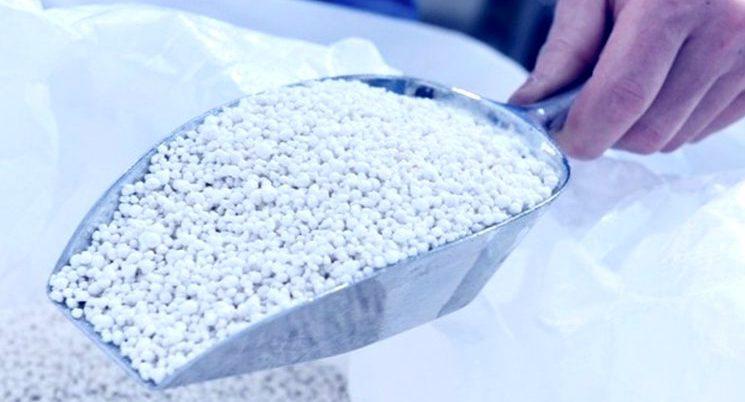

Complex mineral fertilizer for berry bushes
Fertilizers for various types of soil
Blackberries do not have any claims to the soil. However, it is best to grow the crop on well-drained, fertilized loamy soils that have a neutral or slightly acidic reaction. Limestone soil is not suitable for this crop. It is low in iron and magnesium, so the culture can get sick with chlorosis. Acidic soils with a pH of 6 are most suitable for the plant.
Sandy and poor soil needs to increase its water retention capacity. To do this, it is fed with organic fertilizers. Chernozem soils are also suitable for blackberries. The carbonate layer of such soils should be below 1.2-1.3 m. Clay soils are not suitable for culture.
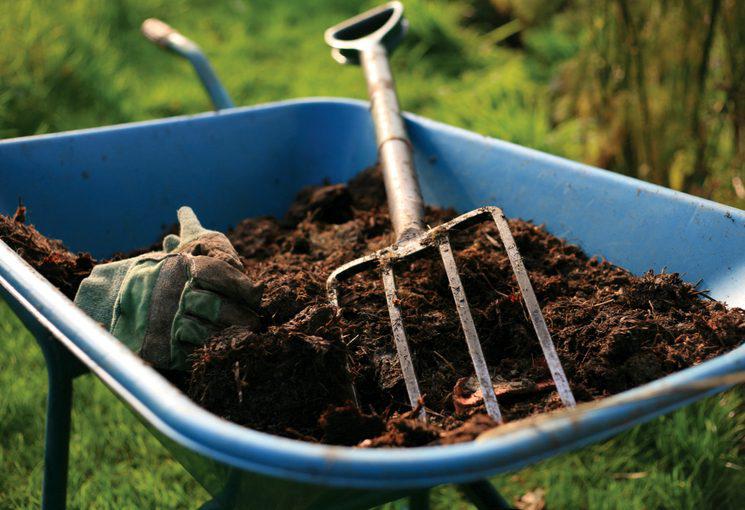

Reproduction in spring and autumn
Experts recommend that this process be carried out in the spring or autumn:
| Spring | Fall |
| Cuttings, seeds, dividing a bush, offspring | Cuttings, dividing the bush, layering |
| Cutting and dividing the bush should be before the plant leaves the leaves, and the offspring are separated at the end of spring. Specimens multiplied in spring always manage to root perfectly before frost | Layers should have time to root long before the onset of cold weather. This method is not always possible in the northern regions or is done in the summer so that the plant has time to root sufficiently. Green cuttings should also be rooted in summer. |
Bush cultivation tools
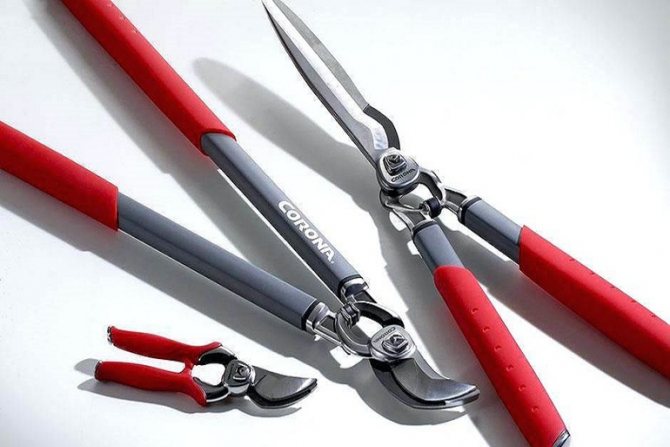

For work, you need to prepare a lopper and pruner. If the diameter of the lignified shoots exceeds 1.5 cm, a garden saw is used.
Prune blackberry bushes with a clean and sharp instrument... Sharp blades make the process easier and faster. The special sharpening of the teeth on the saw and the special setting angle allow cutting branches in two directions. After working with the tool, even and smooth edges remain, which looks more neat. This treatment reduces the risk of contamination of the shrub.
For stems less than 1.5 cm thick, a pruner is used. The device should not break, chew and split twigs, leave uneven cuts.If this happens, choose a tool with the smallest gap between the blades. Anvil pruning shears are suitable for thorny shrubs. When pruning, the tool is constantly held at one angle so as not to break the stem.
Forming and placing whips


There are blackberry bushes with creeping and erect stems, thornless varieties and with numerous straight or curved thorns. As the berry bushes grow and develop, young lashes are tied to a support. Blackberry bushes should not grow in a free direction.
Without a garter, long young and old stems are intertwined, making it difficult to form a bush. On creeping varieties that are located on the ground, the lashes will quickly take root, and the berries will rot. The use of special trellises facilitates pruning and harvesting.
There are two methods of forming a bush:
- The fan-shaped (vertical) method is used for upright species. The stems of the plant are fixed on a fan-shaped support. Last year's branches are tied vertically, young shoots are placed horizontally on the sides. After harvesting, the fan ribs are trimmed above the ground. The central old branches are removed at the root, new shoots are collected in a bunch, shortened to a height of 1.5 m and loosely fixed on the trellis.
- The rope (horizontal) method is suitable for the formation of clinging and creeping species. Long flexible stems are spirally wound on the support on one side, the growing shoots are similarly fixed on the other side. With this method of garter, the collection of fruits will alternate every year. In the fall, the fruit-bearing lashes, weak and damaged young shoots are completely cut off.
How to transplant a blackberry bush: transplant rules
It would seem that a blackberry grows in the garden, bears fruit, and why bother it, transplant it, and worry if it will take root. The fact is that the culture grows well in one place for 10-12 years, and then the bush begins to age, which is manifested by a decrease in yield, a decrease in the number of young growth. When this begins to occur, it is recommended to transplant the bush to another place. From the point of view of biologists, transplanting renews and rejuvenates the plant, after which it can bear fruit for the same number of years. Also, transplanting can solve the problem of redeveloping the site or planting too large a bush.
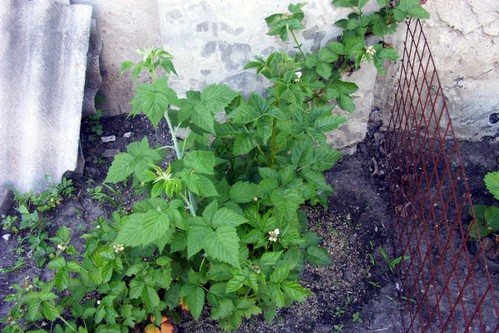

In the transplant of blackberry bushes, two stages can be distinguished: preparatory and main. The preparatory stage consists in the selection and preparation of the site. The following points are taken into account:
- a place must be chosen open to the sun, but at the same time calm - a site on a small hill is best suited, since blackberries do not tolerate excessive moisture and stagnant water, or along the fence from the south or south-west side;
- the site must be cleaned of debris, foliage, roots, if a tape planting is planned (in trenches), then the soil can be dug up - if you suspect the presence of larvae or spores of fungal diseases, it is recommended to water the site with a disinfecting solution (salt, potassium permanganate, or copper sulfate);
- the soil for blackberries should be loose, fertile and slightly sour - loamy or sandy loam soil with the addition of peat and humus is ideal.
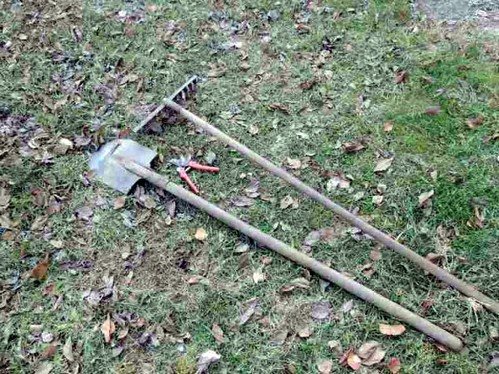

The main stage consists of the following activities:
- breakdown of beds (plantations) - blackberry bushes are planted in a row at a distance of 1.5-2 m for varieties with erect shoots, and 2-3 m for creeping varieties, the distance between rows is 1.8-2.5 m (depending on varieties);
- devices for planting pits or trenches - holes are dug under the blackberry 0.5 m deep and rhizome-wide, with the trench method, a depression is dug up to 0.5 m deep, 2 m or more in length;
- fertilization - as during planting, fertilizers are added to the planting pit (humus or compost 0.5–1 bucket, mineral mixture 100 g), which are mixed with a part of the soil;
- digging the bush from the same place - the ground around the bush is loosened deeply (to make it easier to dig), then they carefully dig in the bush from all sides and take it out together with a lump of earth (the roots are not shaken off);
- an adult bush has a very long main root, and it is not easy to dig it up, therefore, if necessary, you can chop off this part of the root;
- then a bush is placed in the planting hole, the roots are straightened, covered with the remaining earth, and compacted;
- after transplanting, the bush is watered, and the soil around it is mulched.
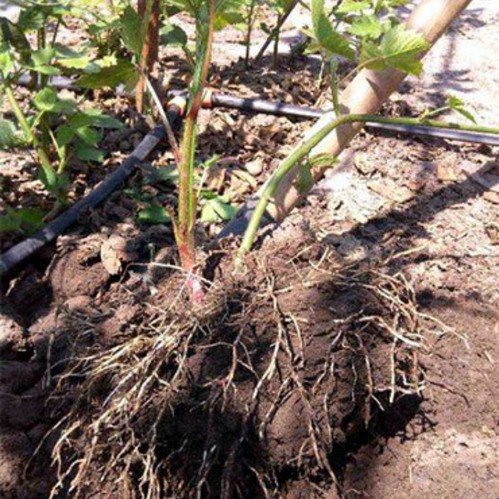

Making folk remedies
Among the home options for feeding this culture, there are:
- Urea treatment... More than half of the composition is nitrogen. It dissolves easily. Recharge is carried out in 2 approaches: during the formation of flowers and during the period when the fruits ripen. 10 g of urea is diluted in water (2 l). Then the bush is sprayed.
- Saltpeter (ammonium nitrate). It is a nitric acid salt. Allocate sodium, potassium, ammonium nitrate. The result of its application is the strength of the bush and an increase in the quality characteristics of the berries. For feeding, you need 20-30 g / sq. m. With low soil quality, 30-50 g / sq. m.
- Egg shell use... It is a fertilizer with a high level of calcium in its composition. It also contains: iron, magnesium, fluorine, phosphorus, etc. To prepare the fertilizer, the shell is crushed and then watered. In this state, the shell is left for a day. The next day, pour the mixture under the bush.
- Yeast: all varieties tolerate well. Also, yeast will be beneficial for microorganisms living in the ground. To prepare the mixture, they are taken dry and diluted in warm water: 10 g / 10 l. Then add sugar (2 tbsp. L) and stand for 2 hours.
- Feeding with compost... It is a composition that consists of plant or animal waste (weeds, grass, etc.). It is applied as mulch with or without digging. In a pit for planting humus is laid out in the spring and autumn.
- Seaweed... They include 60 microelements, nutrients, growth elements that fight fungus and diseases, and also repel harmful insects, improve the quality of the soil, and are part of the compost.
- Shoddy... Top dressing consisting of wool waste. It contains nitrogen and decomposes well in the ground. This type of feeding is applied in autumn and winter. Use 6 kg / sq. m.
- Manure... They are fertilized with berries for several years only once. Before its introduction, the soil is loosened, then manure is placed, mixed with the earth (5 kg / sq. M). During the autumn digging add: 1 sq. m mix 5 kg of manure, 40 g of potassium sulfate and 30 g of superphosphate.
- Chicken droppings... It is one of the most effective dressings. It includes nitrogen, phosphorus, calcium, potassium, magnesium, sulfur, lime, etc.
To improve the quality characteristics of chicken manure, it is dried and kept in plastic containers with holes for better air passage.


Chicken droppings - top dressing for the soil
For feeding with droppings in the fall, use a bucket of mixture (3-7 kg per 5 sq. M). Once the culture feeding procedure is carried out in May-June, another - during the formation of berries, the third time, when the fruits ripen.
Is it possible to grow blackberries from seeds
Although new varieties of blackberries are obtained by sowing seeds obtained by manual pollination of flowers, this crop is propagated mainly in a vegetative way, that is, by rooting parts of the plant.
Large-fruited and remontant plants are obtained by complex hybridization of various blackberry species, and it is pointless to sow the seeds collected from them.
Seedlings begin to bear fruit in the third - fourth year after sowing.
Why propagate blackberries by seeds
Nurseries sell modern varieties - large-fruited, with berries weighing 8-16 grams, but requiring shelter for the winter and mandatory treatments from diseases and pests.
Some varieties declared by the manufacturer as not requiring shelter for the winter, such as Brzezina, Ebana, Chachanska Bestna in the conditions of Belarus and in most of Russia, have to be sheltered. This is not convenient for everyone.
And the old varieties, such as Agvaam, Izobilnaya, Ufimskaya local with berries weighing 3-4 grams, are not bred by professionals.
It is dangerous to take seedlings from grandmothers in the market, suddenly you bring some kind of infection into the garden. And with seeds - no risk.
If the package says that berries weighing 6-8 grams, you should not buy seeds: it is not clear from which varieties they were collected. But the promise of amazingly sweet berries is a slight exaggeration.
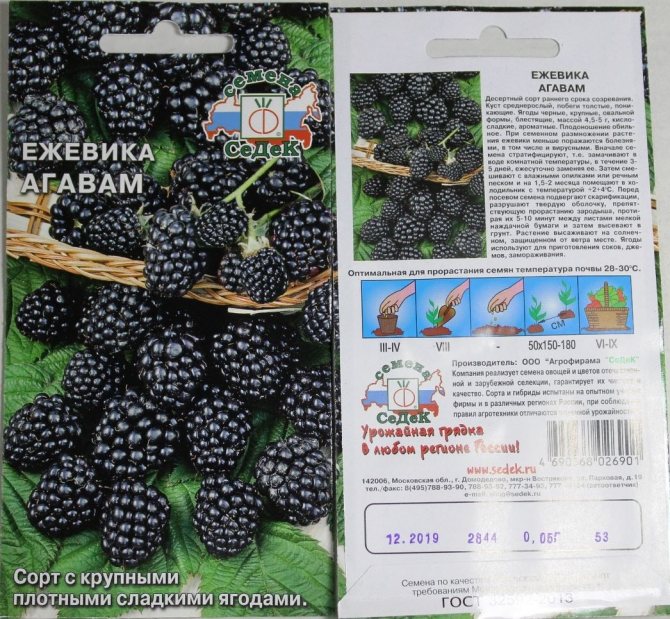

Seedlings grow slowly and begin to bear fruit 3-4 years after sowing
Seedlings grow very slowly.
But for regions with cool and cold climates, sowing has many advantages.
Plants from seeds (not only in blackberries, but in most plants propagated vegetatively, potatoes, garlic, etc.) are more resistant to diseases, pests, and the vagaries of the weather. It is even better if you collect and sow seeds from ripe berries on the best seedlings. Michurin was already convinced of this in his experiments. At the first sowing, only 40% percent of the seedlings had all the necessary properties, and those grown from seeds selected from the best of these bushes turned out to be more productive and hardier than the mother plants.
All the rules for growing blackberries: we plant, form, propagate and process from pests:
How to sow blackberries
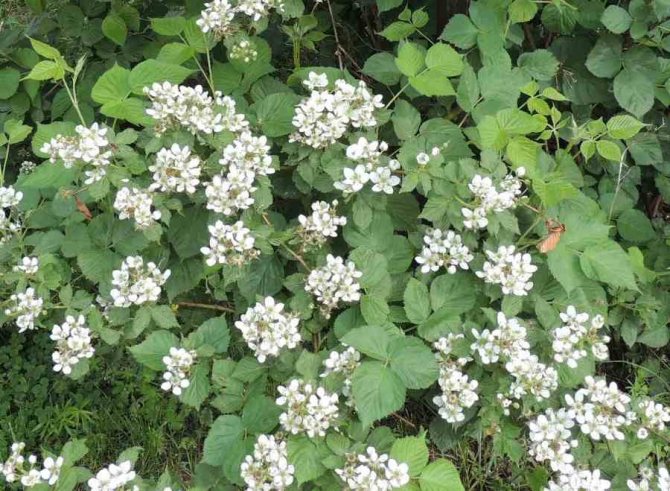

blackberry seeds from accidental pollination for sowing should not be taken
Getting blackberry seeds to germinate is not easy.
For them to hatch, stratification is needed, that is, long-term storage of moist seeds at temperatures close to zero. First, the seeds are thoroughly washed and soaked in water without chlorine for a day. Then mixed with thoroughly washed and calcined wet sand... The latter is taken 1-2 tablespoons, the mixture is poured into a clean disposable container with a lid and sent to the refrigerator.
Blackberry seeds germinate best if the temperature for the first two weeks is slightly above zero, then they are kept at -50C for about a day, and then for about a month at + 20C - + 50C. In this case, every week it is necessary to check and, if necessary, moisten the mixture. You can, of course, keep the seeds at freezing temperatures for the entire period. But then the period between sowing and germination will be one and a half to two times longer. It is important to open the container twice a week and ventilate for a few minutes.
If there is no time for stratification, scarification is carried out - artificial damage to the seed coat. There are different methods, but the easiest to use is mechanical scarification. Dry seeds need to be scratched. With small ones, like blackberries, they do this. A cut piece of sandpaper is placed in a small plastic box to completely cover the bottom. The seeds are mixed with a teaspoon of fine sand and poured into a box. Then the mixture of seeds and sand is rolled over the sandpaper with a small plastic lid. No effort, the seeds must be scratched, but not flattened.
Then disinfection - in a solution of potassium permanganate (0.5 grams per 0.5 liters of water) for 15 minutes, followed by rinsing, or for a day in a solution of phytosporin (8-10 drops per glass of water).
Soil for sowing seeds is made up of a mixture of peat of an average degree of decomposition and vermiculite in a ratio of 5 to 1. Drainage is poured at the bottom - agroperlite, fine expanded clay or sand. The surface of the soil poured into boxes or pots is leveled and slightly compacted, watered. Seeds are sown at a distance of one and a half centimeters in a row and two - between rows. Each seed is pressed to the soil, and sprinkled on top with sand or vermiculite, with a layer of 4–5 mm.
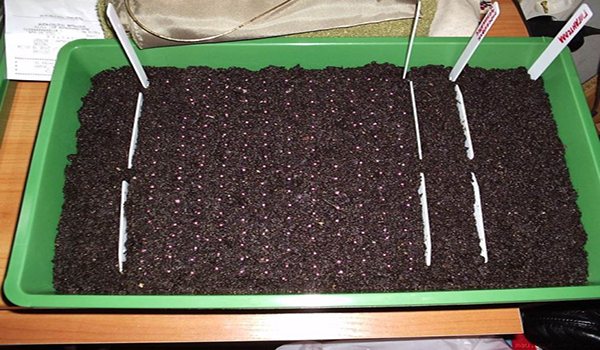

When sowing, the seeds are laid out on moist compacted soil, and on top they are covered with a light substrate with a layer of 5 mm
The box is covered with glass, the pots can be with cling film. Before the emergence of seedlings, they are aired twice a week, and with the emergence of seedlings - daily. Temperature for germination is 22–260 C. Drizzle with water at room temperature, under the root of a teaspoon, in moderation, avoiding dampness. From sowing to germination - 2 to 4 weeks. If a month and a half has passed, and there are no shoots, either they overdid it with watering, or the seeds are of poor quality.
Seedling care
After sprouting for 4–5 days, tiny plants are gradually accustomed to fresh air, opening for 15–20 minutes 1–2 times a day. During this period, illumination is indispensable. With the appearance of the second true leaf, the seedlings dive. It is important not to damage the tip of the main root.
Top dressing begins after the appearance of the first true leaf between the cotyledons, The first time the seedlings are sprayed from a spray bottle with a weak solution of Fitosporin, the dosage is half that indicated on the package. After 2-3 days, feed under the root with the same solution.
The time of sowing seeds, depending on the date of the proposed planting. Seedlings by the time of resettlement in a greenhouse or greenhouse should be at least 30 days old, and under temporary shelters - 45. In the northern regions they are planted in June, when the threat of frost has passed, in the southern regions - at the beginning of September, since in the spring the seedlings do not have time to take root before the onset heat. Residents of Central Russia, the Black Earth Region, South and Western Belarus can plant seedlings both in May and at the end of August, but always under cover, in a greenhouse or greenhouse.
Young plants are planted according to the scheme 30 by 20 centimeters in loose, organic fertilized soil with a slightly acidic reaction. If you plant without destroying the earthen ball, 100% of the seedlings will take root.
Before freezing, bushes growing in open ground are slightly huddled.
They are planted in a permanent place in the spring of next year.
Planting and transplanting blackberries, although they have some nuances, are not so difficult that even a person far from gardening cannot cope with this:
Types of blackberries
Without exception, all blackberry varieties can be divided into three main types: kumanika (differs in erect stems), dewberry (with weaving branches) and semi-creeping intermediate species.
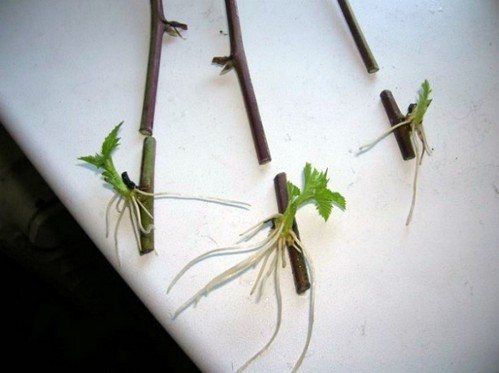

Kumanika is a plant with erect stems, which is characterized by propagation by root shoots. It is to this group that most varieties belong that easily survive the winter, even if they are not covered. For example, one of the most resistant varieties is Flint, which can withstand temperatures as low as -40 degrees.
Creeping shoots with large and juicy berries are characteristic of the dewweed. These varieties can be propagated by cuttings or by rooting the tops. Garden blackberries of these varieties are more productive, but they endure the winter harder, they must be protected from frost.
If we talk about intermediate forms, then more than enough of them have appeared recently. They differ slightly in terms of fruiting time, fruit shape, degree of resistance to pests and diseases.
And recently, something new has appeared: now blackberries without thorns are available to gardeners. The berries on such plants are absolutely not inferior in taste and marketability to their prickly counterparts, but the harvesting process is simplified by far.
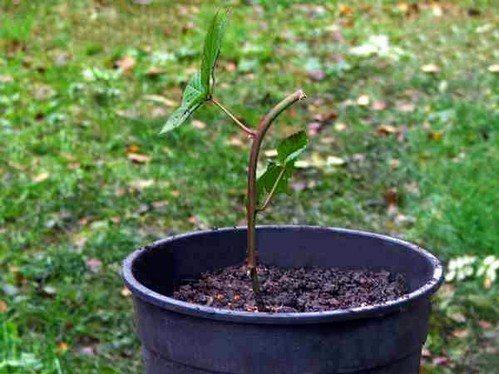

Choosing bushes for grafting
Only acquired young plants are not used for cutting cuttings, even green ones.
After transplanting, the bush directs all its forces to take root after transplantation. Strong, healthy plants are needed, transplanted at least 10 months ago.
Blackberry propagation by root segments
If you intend to cut root cuttings, consider the following:
- Thornless varieties, when propagated by roots, can give thorny plants (while the remaining characteristics of the variety are preserved);
- The plant from which the roots were cut will not be able to be used in the future to obtain berries, but only for reproduction;
- The thickness of the root cuttings affects both the speed of awakening of growth points and the viability of young shoots. In theory, segments with a thickness of 3 mm or even less are suitable. But practice shows that the optimal root diameter for grafting is from 5 to 8 mm. You should not destroy good bushes if they have less roots.
- Creeping blackberries reproduce well by rooting the tops, cuttings with this are not cut. This makes no sense, a four-year-old bush, under certain conditions, is capable of producing up to 30 seedlings ready for planting per season.
- If you plan to cut seedlings, it is important to first make sure that the specimen is of suitable quality - it does not give abundant root growth, the berries are of good taste and a sufficient part of them will have time to ripen. Until the bush gives a full harvest, this is impossible to understand. But you can root 2-3 tops from a bush. Just do not rush to distribute the resulting seedlings to friends or acquaintances until you are sure of the quality.


From thick roots and strong sprouts
Cut the roots into pieces 5–6 cm long just before planting. Until this moment, they are stored in a slightly moist, loose substrate (for example, a mixture of peat with sand).
The best results are obtained by planting root cuttings in the greenhouse in March - early April. The soil at this time is still cold, and it must be spilled with boiling water, and on top of it pour nutrient soil, warmed up in the room to room temperature. The composition of the substrate is a bucket of peat and humus and half a bucket of sifted sand.
Before planting, the roots are soaked for two to three hours in a solution of the Fitosporin preparation. They are laid out on the surface of the poured substrate in rows so that it is convenient to care for the grown sprouts. Cover the top with the same substrate with a layer of 4–5 cm and sprinkle with Fitosporin. This drug will prevent diseases of future sprouts. Arcs are installed on top and the covering material is pulled.
You can grow seedlings from root cuttings and in the room. In this case, backlighting is required.
You can start germination from mid-January, then a 0.5 liter pot will be enough for plants before planting in a greenhouse or greenhouse. The roots are washed, then soaked in Fitosporin and after 2 hours the cuttings are cut with a sharp knife and planted in boxes. The soil is made by mixing peat with agroperlite or vermiculite in an arbitrary proportion. You can even take pure perlite, but more often they take 4 parts of peat for one part of perlite.
Within a week, the first shoots appear, within three weeks after planting, all cuttings will germinate. It is better to plant roots of various thicknesses in separate boxes or containers: sprouts from those that are thicker are ready for picking into cups earlier.
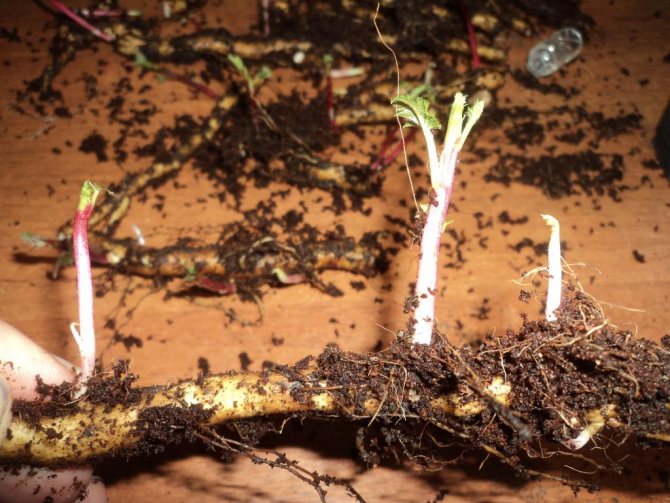

several shoots grow on one root segment
Before planting, the boxes are watered abundantly, it is easier to remove the seedlings from the soaked substrate without damaging them.
At the bottom of the glass, which has holes for water drainage, drainage is poured with a layer of about a centimeter. Then, up to half the height, they are covered with a mixture of humus with peat and the addition of perlite. Then add some clean peat. The upper part of the glass is filled with a mixture of peat with perlite 1 to 1. The roots of the seedlings should neither bend during planting, nor touch the nutrient mixture with humus. Until they take root, the roots are in the upper part, where there is only peat and perlite. When growth begins, the roots will quickly reach a fertile mixture.
Waterlogging and cold in the first two weeks after transplantation are destructive.
For any suspicious change in leaves, even on one plant, do a tick treatment. Aktelik can be used in the apartment.
Video: Master class on growing blackberries from roots from a specialist
Winter storage of blackberry stem cuttings
From well-ripened stems at home, seedlings of varieties that do not have thorns, as well as remontant blackberries, which do not give root suckers, are obtained at home. The upper quarter of the shoot is not suitable for cuttings. Cutting the stems into cuttings is done immediately before germination.
If there is a greenhouse, lay the stems, without cutting off the tops, horizontally on the soil surface, and sprinkle slightly moistened peat on top with a layer of 15–20 cm. In February, they are dug out, cut into cuttings and rooted. If the stems are laid on a board, it will be easier to dig up.
But if the dacha is far away, the cuttings are stored in the refrigerator. They are cut into pieces 35–40 cm long, and small potato tubers are planted at the ends. Small cuts are made in the tuber, and up to 5 stems can be inserted into each. Then it is wrapped in a dry linen cloth, placed in a bag and stored in a refrigerator or in a cold cellar (temperature not higher than +80 C).
How blackberries reproduce
You can grow blackberry seedlings at home or in a greenhouse, and some varieties are propagated directly in the beds. Creeping varieties and drooping species, intermediate between straight-growing and mildews, take root at the top of the stem. Others give root suckers like raspberries.
In addition, blackberries are propagated by cuttings or horizontal layering (by dropping young shoots). Saplings of many thorny varieties are obtained by germinating root cuttings in greenhouses or indoors. There are even blackberry seeds on sale.
Seeds
Many varietal varieties of blackberries can be propagated by seeds, retaining all the characteristics of their species.
Did you know? The famous biologist and breeder Ivan Michurin argued in his works that when propagated by seeds,
more hardyseedlings. They have better frost resistance than their manufacturers.
The seeds can be used from their own berries. For this purpose, you need to wait until the fruit is fully ripe and dry it. To improve the germination of seed, you can carry out the scarification procedure (partial damage to the hard shell of the seed by mechanical or chemical means) or stratification (subject to lower temperatures). Before sowing for a couple of days, it is advisable to place the seeds in snow or cool water.
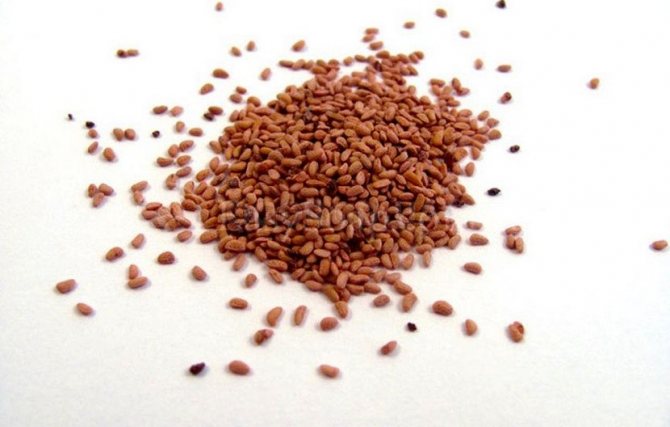

The soil for crops should be taken light and loose - peat or moistened sand. The seeds are buried up to 8 mm. The gap between them is 3.5–4 cm. After planting, the soil is lightly tamped and watered. The container with crops is placed in a cool room with a set temperature of + 2 ... + 5 ° С for 4–6 weeks. Planting is moderately moisturized. Then the container is moved to a room with an air temperature in the range of + 20 ... + 22 ° С. When 3 true leaves are formed on the sprouts that have appeared, they can be transplanted into a prepared place in the garden.
We recommend that you learn how to grow blackberries from seeds at home.
Summer blackberry transplant - pros and cons
Transplanting blackberries in the summer does not give high percentages of seedlings survival, since in hot weather, bushes dug out of the ground quickly wither and die. In order for this event to be crowned with success, the following recommendations must be observed:
- Landing should be done in the morning or evening hours, before dawn or after sunset.
- The transplant should be performed as soon as possible and a sun shelter should be built immediately afterwards.
- Transplanted bushes need to be watered often and abundantly with water - at least 1 time per day.
Sleeping kidney
To do this, in the first days of October, you need to cut pieces 15 cm long with 2-3 buds from annual woody shoots. They are cleaned of leaves and placed on a refrigerator shelf or in a cellar. In late February or early March, they are taken out and immersed in a jar of water with the upper kidney. Only this dormant bud is submerged under the water, while others are above its surface. Roots will appear from the kidney immersed in water.Then it is cut off from the cutting and planted in a pot with a substrate. Then the next bud is immersed in water and the rooting process is carried out again. This is how the seedlings are made from all the buds on the handle.
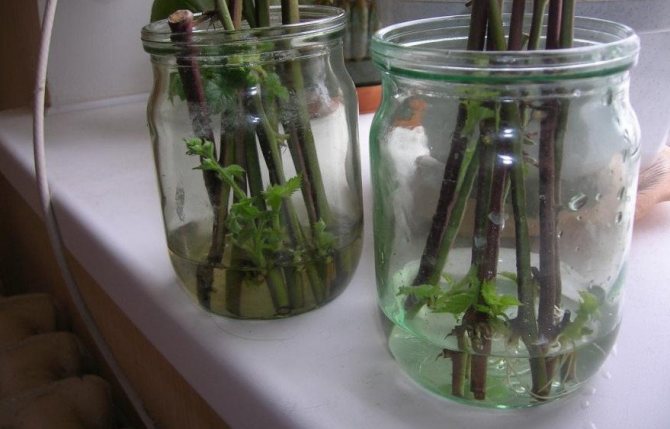

A container with cuttings is placed on a windowsill well-lit by the sun and periodically add water and replace it.
What is the autumn pruning of blackberries for?
To prepare the blackberry for winter, you need to rid the plant of excess green mass.
Competent pruning will allow the bush:
- Rationally use nutrients between branches that will bear fruit next season and will not feed useless old stems.
- Do not freeze out in winter.
- Increase immunity to fungal diseases in the off-season.
- It is more active to form buds of growth and flowering, large berries.
- Get a lot of sunlight for the growth of shoots, ripening of fruits, as the shading of young and fruiting lashes will decrease.
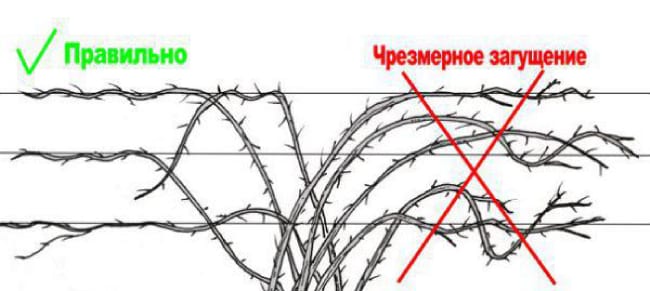

Blackberry bush formation
How to transplant blackberries to a new place in the fall
Blackberry shoots are dug out carefully without damaging the roots, with a clod of earth, and transplanted to a permanent place. The same shoots at the same time are used for cutting single-bud cuttings from the upper third of the shoot (except for the last two buds). Cuttings, consisting of a part of the stem, bud and leaf, are treated with a growth stimulator and planted for rooting in a container with soil mixture (peat and perlite (or sand, vermiculite, crushed expanded clay, etc.) in a ratio of 2: 1). Cups with cuttings are placed in a "greenhouse bag", cuttings are often sprayed.
Blackberries are planted in the sunniest and most protected place in the garden (near the southern wall of the fence or the southern slope), otherwise the berries ripen poorly and the yield decreases. Pruning and shaping blackberry bushes can significantly increase their fruiting.
Prepared the answer by Ziborova E.Yu.
All about blackberries
Online
Offspring
A young shoot growing from a rhizome is called a scion. In this way, erect blackberries multiply. During the summer season, about twenty young offspring grow around the bush. Basically, such shoots are removed so as not to interfere with the development of the mother plant.
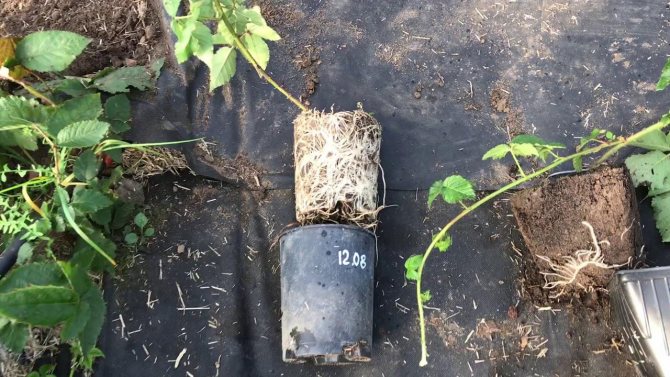

For breeding, offspring are carefully selected:
- The mother shrub should be high yielding and healthy, and the shoot from it should be 10 to 12 cm in size.
- The selected offspring in May or early June is carefully separated from the adult bush using a bayonet shovel.
- Organic fertilizers are added to the finished pit, then the shoot is placed there, mulched and spilled well.
If in the spring the offspring are still weak and underdeveloped, they are left until autumn near the mother bush, providing increased care, and in September the matured plants are planted.
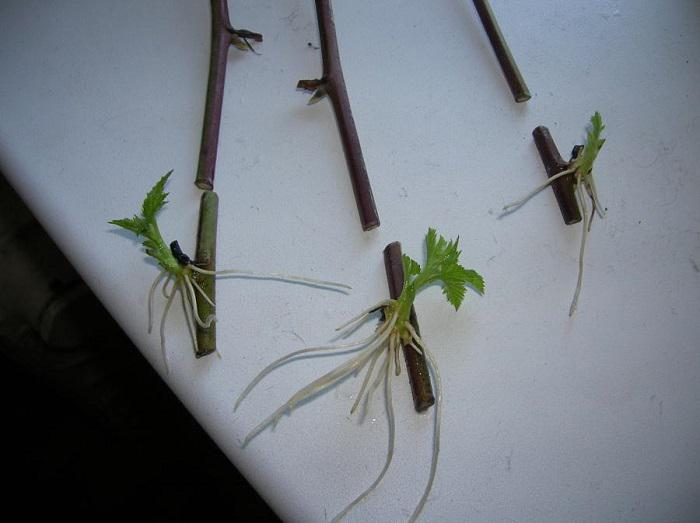

The most effective method
Blackberry transplant in spring
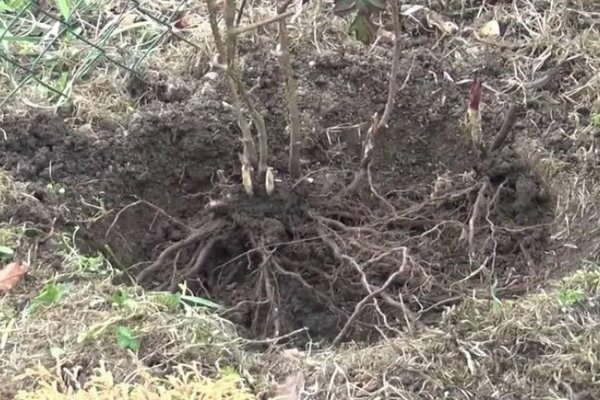

The actual blackberry transplant in the spring includes the following steps:
- The site intended for the placement of blackberry bushes should be planned in advance. It is traditional to arrange blackberries in rows, the distance between which depends on the variety of the blackberry and its ability to grow. On average, it fluctuates between 180 and 300 cm.The interval between individual bushes should also be quite large: erect varieties need an interval of at least 200 cm, creeping ones - about 300 cm.
- When digging planting holes, you should be guided by the size of the root system of the seedling. For cuttings obtained from root growth, a depth of up to half a meter will be sufficient. Adult bushes need a larger, extensive pit in which its developed root system will be placed. It is recommended to plant blackberry bushes in recesses in the form of trenches, dug in the entire length of the rows. Their average depth is 50 cm.
- A nutrient mixture should be added to each planting hole, which includes organic components - for example, compost (1 bucket). Another option is to fertilize the soil with the addition of mineral complexes (0.1 kg per well).
- The blackberry bush to be transplanted is dug in from all sides, removed from the ground and, together with an earthen lump, is transferred to the planting hole. In cases where the plant has a root deeply embedded in the ground, it can be chopped off with a shovel - it is almost impossible to extract such powerful roots.
- After being placed in the planting hole, the root system of the bush is covered with earth, then the site is watered abundantly with water. The surface of the soil is covered with a layer of mulch. It is necessary to keep the soil in the area with blackberries constantly moistened before the seedlings finally take root.
Blackberry benefits
Blackberries have collected a gorgeous set of vitamins that are useful for the human body. It is worth trying the blackberry fruit once, and you will never forget this pleasant and unusual taste. It is not at all troublesome to grow high-yield blackberry bushes in your country house.


Every gardener is proud that this magnificent berry grows on his site. I plant the blackberry near the fences, thereby making magnificent hedges, which can be an addition to the design of the suburban area.


Many residents of Russia perceive blackberries as a novelty. And this is understandable, because raspberries, currants or gooseberries are much more popular. And if you take this into service, then you can earn a certain capital on the sale of seedlings.
The more you want to harvest, the more seedlings should be planted. The risks of death of bushes from weather disasters, disease or harmful insects are reduced to almost zero. And if a few plants do not bear fruit this season, others will fulfill its function.
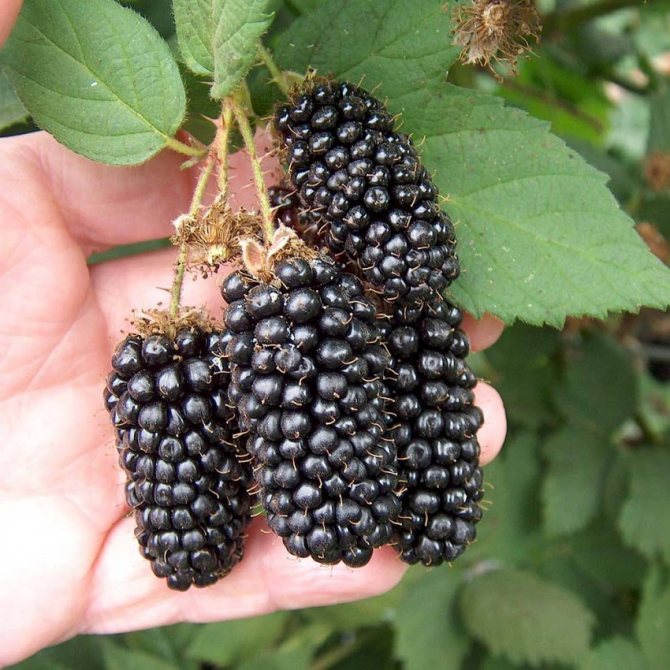

Dividing the bush
Everything is nowhere easier. The main thing is to follow the procedure:
About a couple of days before the procedure, the blackberry bushes should be well watered. If you neglect this point, there is a strong risk of damage to the roots when dividing the bushes.
Around the entire perimeter of the bush, you need to dig a groove so that it is located about 40 cm from the stem. All roots that are beyond the border of this groove should be cut off with a shovel bayonet.
The bush for dividing must be dug up and carefully dug.
The bush should be divided so that each part has 1-2 stems of that year with roots.
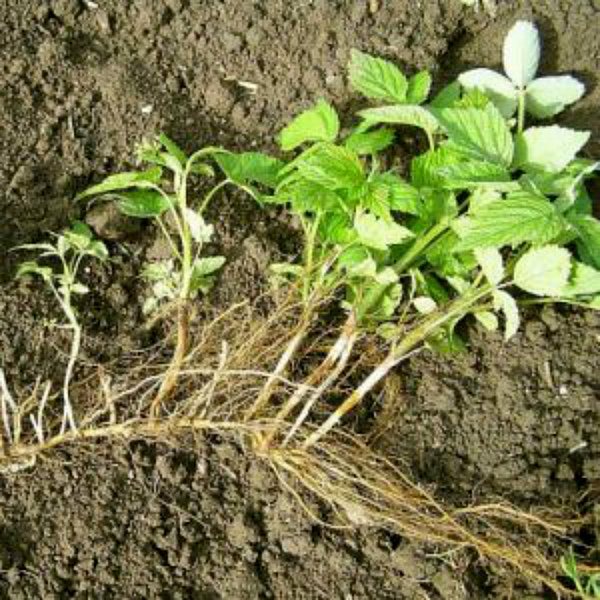

All parts of the bush must be prepared for planting by cutting off damaged roots and old stems. Healthy shoots should be shortened. Their length should not exceed 30-40 cm. It is imperative to ensure that at the roots of each part of the bush there is at least one underground bud.
It is necessary to plant blackberries so that the distance between the seedlings is at least 2.5-3 meters.


